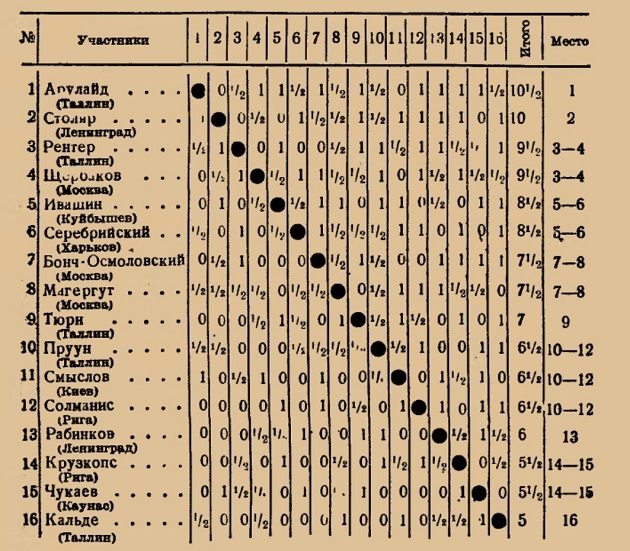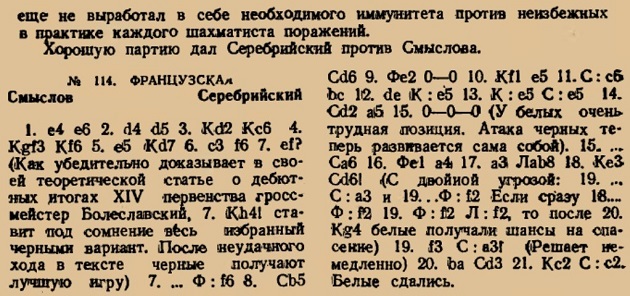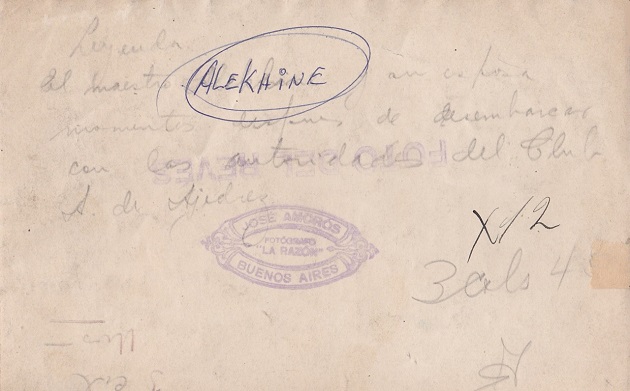Chess Notes
Edward Winter
When contacting us by e-mail, correspondents are asked to include their name and full postal address and, when providing information, to quote exact book and magazine sources. The word ‘chess’ needs to appear in the subject-line or in the message itself.
| First column | << previous | Archives [146] | next >> | Current column |
10091. Simultaneous display
Peter Holmgren (Stockholm) sends this photograph, found in a local archive in Gävle:

It appears to show Rudolf Spielmann giving a simultaneous exhibition in the early twentieth century. Can further information be found?
10092. Strenuous amusements
From John Hilbert (Amherst, NY, USA) comes an item on page 4 of the Brooklyn Daily Eagle, 18 May 1902:

10093. C.G. Watson
A feature on page 43 of CHESS, November 1946:
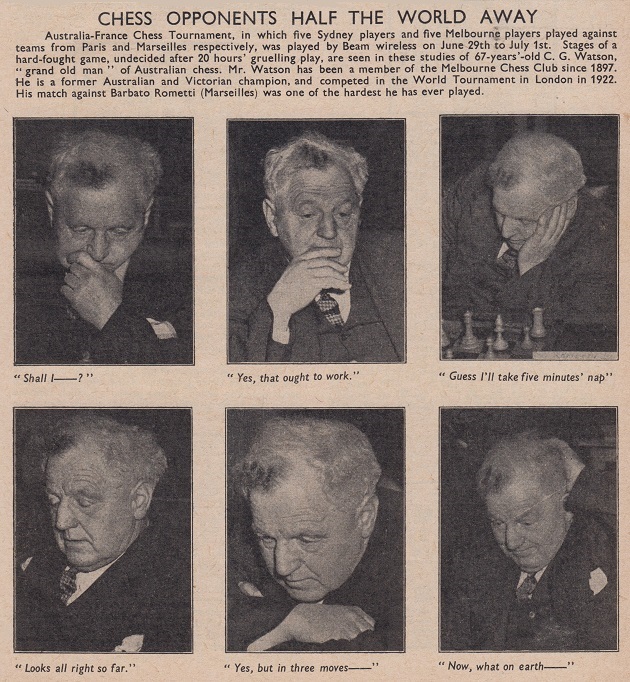
An article entitled ‘Watson the Unique’ by C.J.S. Purdy in the 1 November 1949 issue of Chess World had the following on pages 252-253 regarding London, 1922:
‘Then Watson went to London. It meant crashing into a field which included Capablanca, Alekhine, Vidmar, Rubinstein, Bogoljubow, Réti, Tartakower, Maróczy, Euwe and Co. It’s our firm belief that Watson, bred in the same environment as any of these, would have become a grandmaster himself – but when one considers that before this event he had competed in only one round-a-day tournament in his life, and in his whole 42 years had barely that number of match games against players of his own strength, his score of 4½ out of 15 in that field emerges as something of a miracle. It included four outright wins, the same number that was achieved by Euwe and Znosko-Borovsky. He scored 1½ out of 2 against Britain’s two greatest players, Yates and Atkins, and defeated Réti. He also made a great fight against Vidmar (winner of third prize below Capablanca and Alekhine) and, under time-pressure, missed a forced win against Maróczy.’
On page 261 of Chess World, December 1959 Purdy called Watson ‘Australia’s greatest living native-born player’ and added:
‘The series “Watson the Unique” is the best biographical series we have ever published – except possibly the Alekhine series in 1946.’
‘Watson the Unique’ appeared in three parts: 1 November 1949, pages 249-258; 1 December 1949, pages 275-281; 1 January 1950, pages 2-7.
On page 9 of the January 1962 Chess World Purdy wrote:
‘A circumstance without parallel in Australian chess history is that C.G. Watson, Victoria’s greatest chessplayer, died on 5 March 1961, yet the fact of his death remained unknown in Melbourne or other chess circles till March 1962 – 12 months later.’
10094. Ludwig Bauer
From Lasker’s Manual of Chess (Philadelphia, 1947):
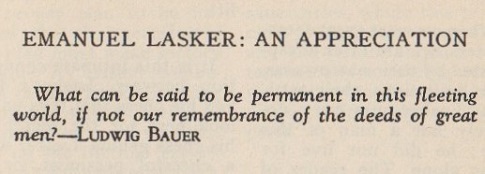
That is the heading of the introduction by Fred Reinfeld to his edition of Lasker’s book. The page was numberless, but in the 1960 Dover reprint it was page vii.
Jean-Pierre Rhéaume (Montreal, Canada) asks for information about Ludwig Bauer and the source of his observation. At present, we can say only that pages 308-310 of the September-October 1908 Wiener Schachzeitung reprinted an article by Bauer which covered similar general ground, though without the remark quoted by Reinfeld.
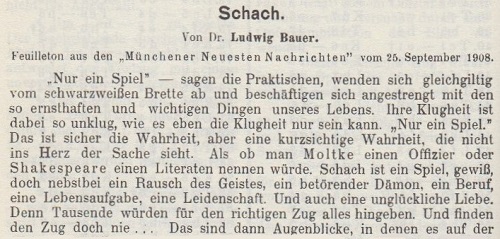
10095. Sea air (C.N.s 5517, 5707, 5724, 9369 & 10017)
On the Tarrasch controversy over the climate in Düsseldorf, an addition from pages 302-303 of the Wiener Schachzeitung, September-October 1908:

This has been extracted from an interview with Tarrasch by Hans Taub originally printed in the Münchener Neueste Nachrichten, 23 September 1908.
10096.
Photographic archives (23)
Our archives include about 40 photographs from the eighth Balkaniad (Athens 10-16 October 1976). A selection:
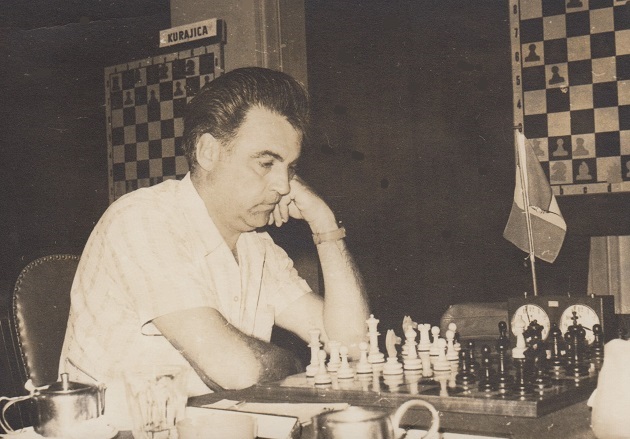
Victor Ciocâltea
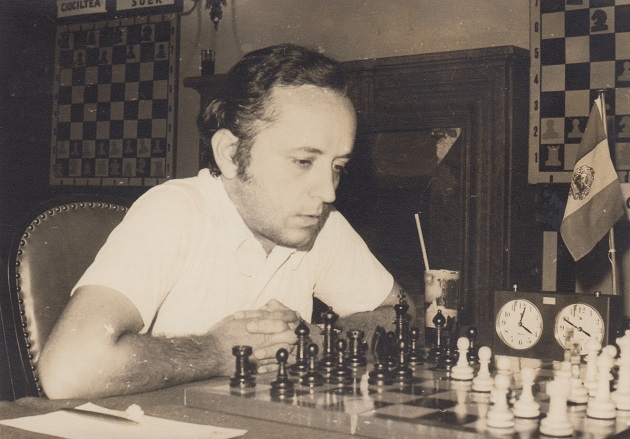
Florin Gheorghiu
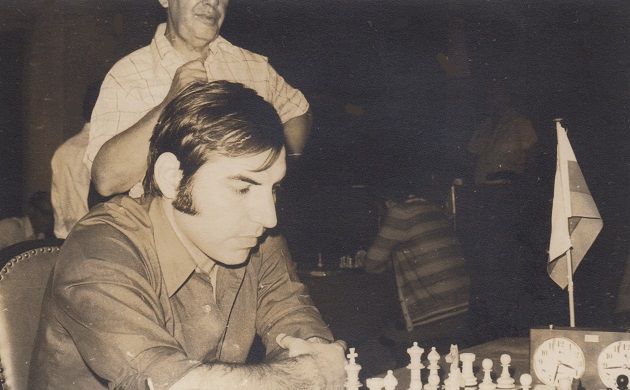
Nino Kirov
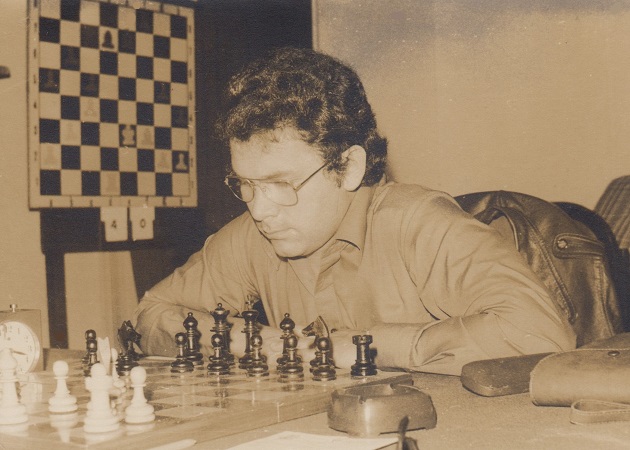
Bojan Kurajica
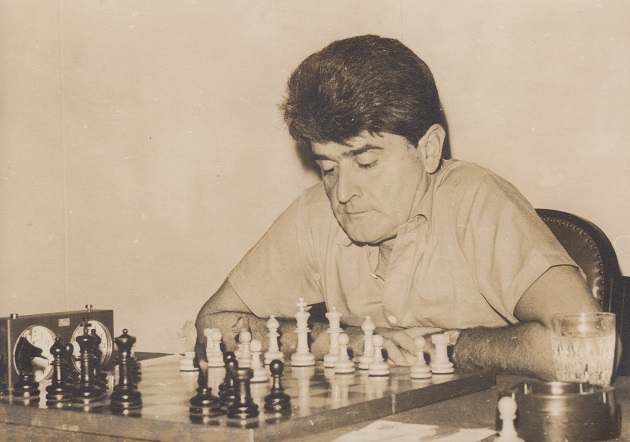
Aleksandar Matanović
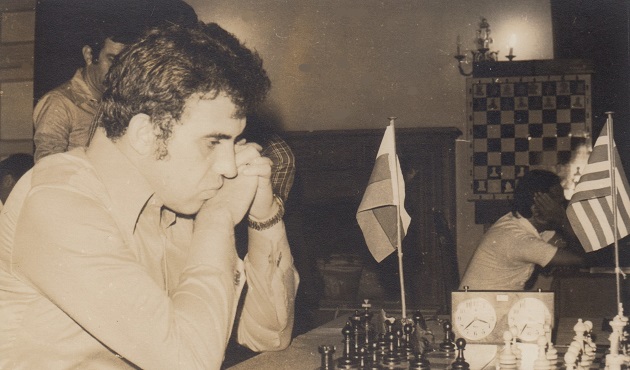
Ivan Radulov
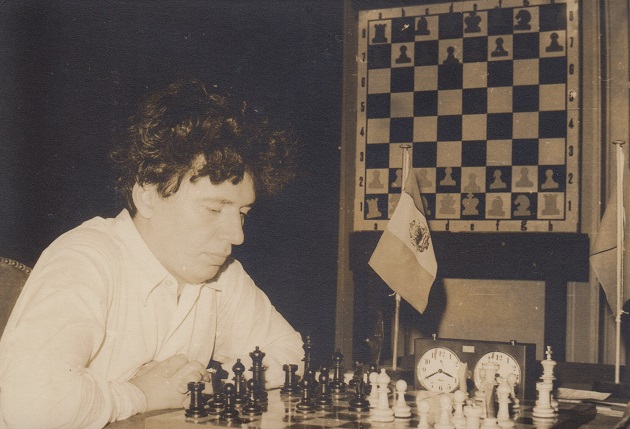
Mihai Șubă
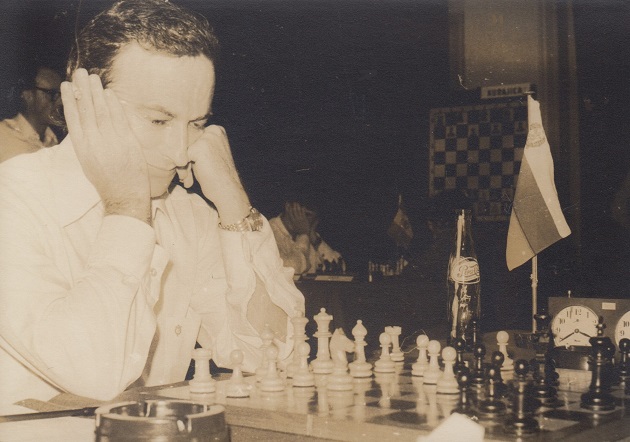
Georgi Tringov
10097. Capablanca in Paris, 1922
Dominique Thimognier (Fondettes, France) sends these cuttings:

Excelsior, 14 May 1922, page 2
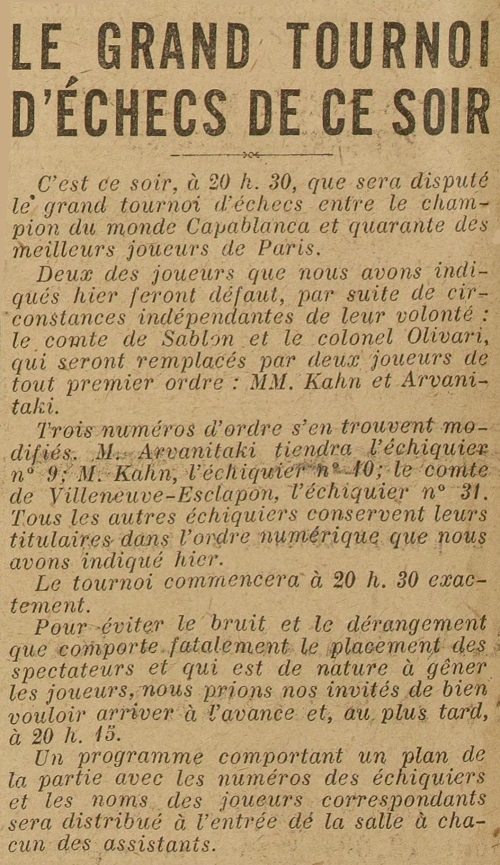
Excelsior, 15 May 1922, page 2
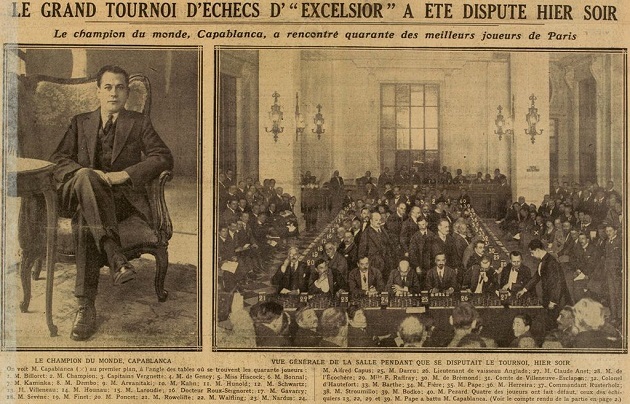
Excelsior, 16 May 1922, page 1 (Larger version)
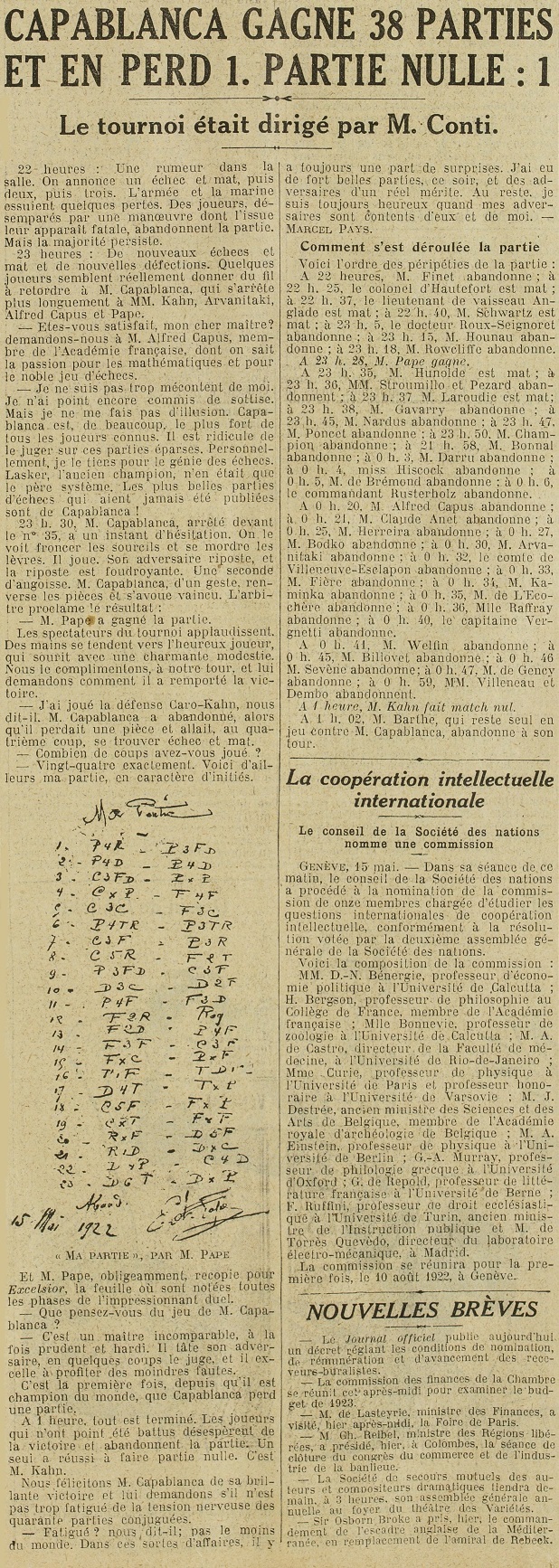
Excelsior, 16 May 1922, page 2
Capablanca’s loss to Pape (1 e4 c6 2 d4 d5 3 Nc3 dxe4 4 Nxe4 Bf5 5 Ng3 Bg6 6 h4 h6 7 Nf3 e6 8 Ne5 Bh7 9 c3 Nf6 10 Qb3 Qc7 11 f4 Bd6 12 Be2 O-O 13 Bd2 c5 14 Bf3 Nc6 15 Bxc6 bxc6 16 Rc1 Rab8 17 Qa4 Rxb2 18 Nc4 Bxf4 19 Nxb2 Bxd2+ 20 Kxd2 Qf4+ 21 Kd1 Qxg3 22 Qxc6 Nd5 23 Qa6 Qxg2 24 White resigns) is known, having been published on pages 159-160 of the July 1922 issue of La Stratégie with Pape’s annotations in L’Action Française.
Mr Thimognier adds that the only other game from the 40-board display that Capablanca did not win was given on page 5 of Excelsior, 28 May 1922:

José Raúl Capablanca (simultaneous) – Victor Kahn
Paris, 15 May 1922
Queen’s Gambit Declined
1 d4 d5 2 Nf3 e6 3 c4 Nf6 4 Bg5 Nbd7 5 e3 Be7 6 Nbd2 O-O 7 Rc1 c6 8 Bd3 Re8 9 O-O Nh5 10 Bxe7 Qxe7 11 Ne5 Nhf6 12 f4 c5 13 Qf3 cxd4 14 exd4 Qb4 15 Rc2 dxc4 16 Ndxc4 Nb6 17 a3 Qe7 18 Nxb6 axb6 19 Rfc1 Qd6 20 Qf2 Bd7 21 Nc4 Qc7 22 f5 Rac8 23 Ne5 Qd8 24 fxe6 Bxe6 25 Rxc8 Bxc8 26 h3 Be6 27 Bc4 Qc7 28 Rc3 Qd6 29 Bxe6 Qxe6 30 Rc7 Re7 31 Qc2 h6 32 Rc8+ Re8 33 Rxe8+ Nxe8 34 Qc4 Qe7 35 Qc8 Kh7 36 Qd7 Qxd7 37 Nxd7 Kg6 38 Kf2 Kf5 39 Ke3 b5 40 g4+ Kg5 41 Ne5 Nd6 42 Nf3+ Kf6 43 b3 Ke6
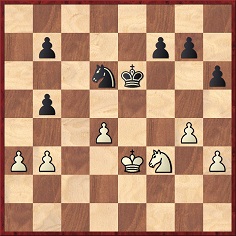
44 Ne1 f5 45 Nd3 g5 46 Ne5 f4+ 47 Kd3 Kd5 48 Nd7 Ke6 49 Nc5+ Kd5 (‘R3D’) 50 Nd7 Ke6 51 Ne5 Kd5 52 Nd7 Ke6 53 Ne5 Kd5 54 Nd7 Ke6 Drawn.
As regards the first Excelsior cutting shown above, Mr Thimognier notes in particular Capablanca’s concluding remarks from his conversation with Roger Valbelle:
‘Je ne me laisse pas absorber. Je suis resté un an et demi sans toucher une pièce. Je ne m’entraîne même pas pour un match. Je n’avais pas joué depuis trois mois lorsque j’ai gagné celui de La Havane. Le souvenir revient tout seul quand il le faut.’
10098. Players named Smyslov (C.N. 5606)
In C.N. 5606 a correspondent drew attention to an article about Bohatirchuk on pages 70-71 of the 6/2008 Rochade Europa which had a crosstable with a player named ‘Smyslov’:
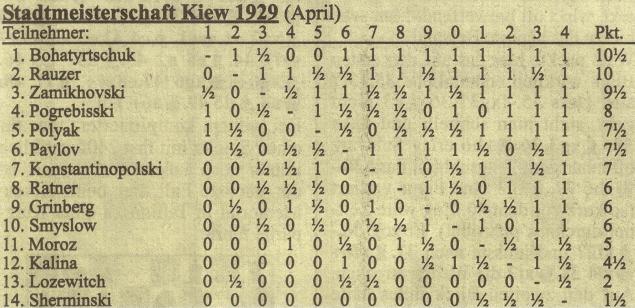
From Andrey Terekhov (Singapore):
‘I have found another crosstable which mentions Smyslov of Kiev, published in the 8/1945 issue of Shakhmaty v SSSR in an article about the All-Union tournaments of first-category players. That year there were four semi-finals in different cities of the USSR. The crosstable of the Tallinn tournament (published on page 233) included Smyslov (of Kiev), who scored 6½/15 and shared 10-12th places. The article also gave, on page 234, a game which “Smyslov of Kiev” lost in that tournament to Serebriyskiy (of Kharkov):
1 e4 e6 2 d4 d5 3 Nd2 Nc6 4 Ngf3 Nf6 5 e5 Nd7 6 c3 f6 7 exf6 Qxf6 8 Bb5 Bd6 9 Qe2 O-O 10 Nf1 e5 11 Bxc6 bxc6 12 dxe5 Nxe5 13 Nxe5 Bxe5 14 Bd2 a5 15 O-O-O Ba6 16 Qe1 a4 17 a3 Rab8 18 Ne3 Bd6 19 f3 Bxa3 20 bxa3 Bd3 21 Nc2 Bxc2 22 White resigns.
A player named Smyslov was also mentioned on the last page of the 13/1937 issue of the Ukrainian-language newspaper Shahist in a brief report on the semi-finals of that year’s Kiev championship:
The semi-finals comprised three groups of 12 players, and the top players in each group qualified for the final. A player named Smyslov was in the second group, but he did not finish among the top four and thereby qualify.
The following chronology is offered tentatively to suggest that Smyslov of Kiev and Vassily Ossipovich Smyslov were different people:
- Vassily Ossipovich Smyslov studied in St Petersburg and began working there in the “Expeditsiya po zagotovleniyu zennyh bumag”;
- He played in a number of tournaments in the early twentieth century;
- After the 1917 Revolution the organization where he worked was renamed “Goznak” and was transferred to Moscow. Vassily Ossipovich Smyslov moved to Moscow;
- Vassily Vassilievich Smyslov was born in Moscow in 1921;
- Somebody named “Smyslov” played in the Kiev championship in 1929 and in the semi-finals of the 1937 Kiev championship;
- Vassily Ossipovich Smyslov died in 1943. (This, together with the above information about him, is taken from V.V. Smyslov’s book Letopis shakhmatnovo tvorchestva (Moscow, 1993);
- “Smyslov of Kiev” played in a tournament in 1945.’
10099. Tal’s opponent
Dan Scoones (Coquitlam, Canada) writes:
‘On page 33 of Tibor Károlyi’s first volume on the life and games of Mikhail Tal, The Magic of Youth (Glasgow, 2014), one early opponent is misidentified:
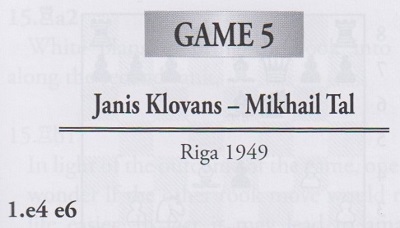
Tal’s opponent was not his future trainer Jānis Klovāns (1935-2010) but another strong master with a similar name: Jānis Kļaviņš (1933-2008). The game Kļaviņš-Kamrad from the same event (“чемпионат школьников Риги”) was published on page 159 of the June 1949 issue of Shakhmaty v SSSR. I have found no suggestion that Klovāns also played in that event.
Jānis Kļaviņš was the Latvian champion in 1952. The Cyrillic version of his name is Янис Клявиньш, which some compilers have rendered as Janis Kliavinsh or simply Janis Kliavin (see, for example, page 3 of Hilary Thomas’s first volume of Tal’s games).
Another game between Kļaviņš and Tal, from the 1953 Latvian championship, was published on page 180 of the June 1953 issue of Shakhmaty v SSSR with annotations by Alexander Koblents.’
10100. Norman Willem van Lennep
Thanks to modern technology and particularly the digitization of newspapers, the discovery of ‘unknown’ game-scores is far less of an exploit than it used to be. As an experiment, we invite readers to send us their findings concerning Norman Willem van Lennep (1872-97), further to the material already available in the C.N. items listed in the Factfinder. The choice of van Lennep puts every chance on the researcher’s side: his name was distinctive, and much of the culmination of his short chess career was in a country (Great Britain) which had many rich journalistic outlets that are now available on-line. Moreover, van Lennep often played in relatively minor club matches of the type more likely to be covered by newspapers than by magazines.
Firstly, readers may appreciate a reminder of his life, as related on pages 161-164 of the May 1897 BCM:

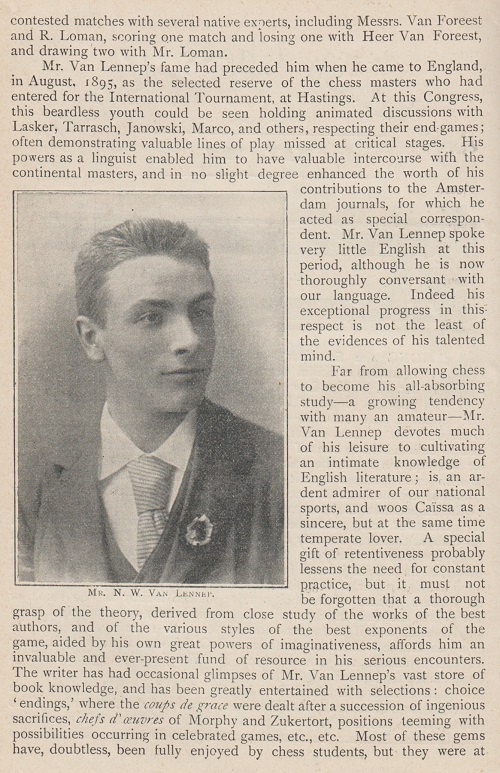
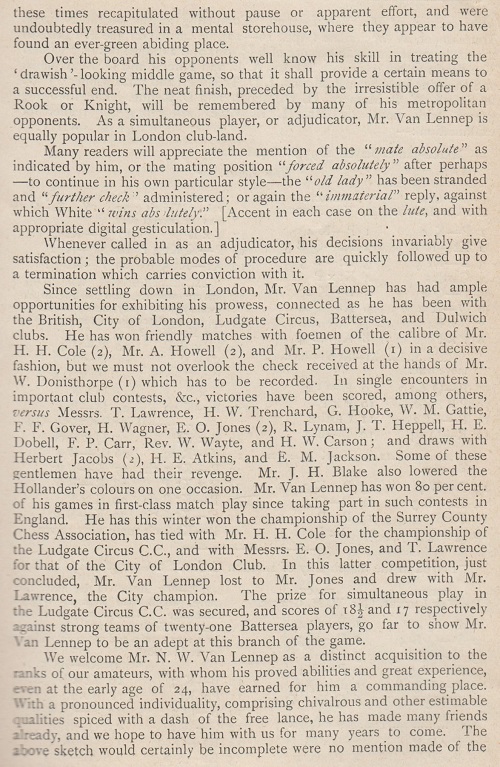

Page 431 of the November 1897 BCM had a curt notice of his demise:
‘We regret to record the premature death of the noted amateur Mr N.W. van Lennep. The sad event occurred late in the month of September, during a voyage to Holland.’
With regard to his games, a win against A.E. Tietjen was published in Isidor Gunsberg’s column in the Penny Illustrated Paper, 7 March 1896, page 149:
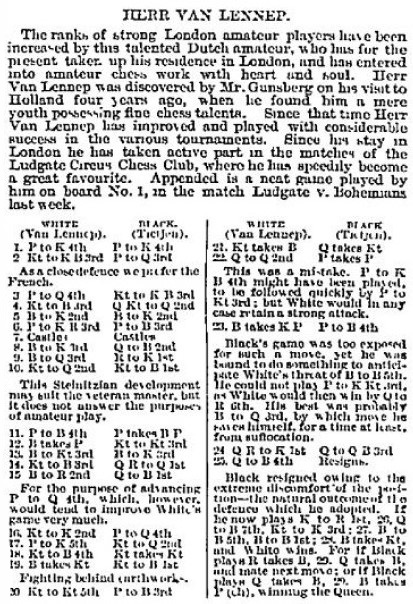
1 e4 e5 2 Nf3 d6 3 d4 Nf6 4 Nc3 Nbd7 5 Be2 Be7 6 h3 c6 7 O-O O-O 8 Be3 Qc7 9 Bd3 Re8 10 Nd2 Nf8
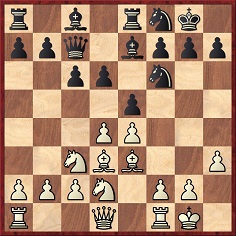
11 f4 exf4 12 Bxf4 Ng6 13 Bg3 Be6 14 Nf3 Rad8 15 Bh2 Qc8 16 Ne2 d5 17 e5 Nd7 18 Nf4 Nxf4 19 Bxf4 Nf8 20 Ng5 f6 21 Nxe6 Qxe6 22 Qd2 fxe5 23 Bxe5 c5 24 Rae1 Qc6 25 Qf4 Resigns.
A loss by van Lennep as White against Percy Howell in the Ludgate Circus Championship in London was on page 8 of the Daily News, 12 January 1897:
1 e4 e5 2 Nf3 Nc6 3 Bb5 d6 4 d4 exd4 5 Nxd4 Bd7 6 Nc3 Nf6 7 Nde2 Be7 8 Ng3 O-O 9 O-O Re8 10 b3 Bf8 11 Bb2 Ng4 12 h3 Nh6 13 Re1 a6 14 Bxc6 Bxc6 15 Qd3 Qd7 16 Rad1 Re6 17 Nce2 Rae8 18 Nd4 R6e7 19 Bc1 f5 20 Bxh6 fxe4 21 Qe3 gxh6 22 Ngf5 Re5 23 Nxh6+ Bxh6 24 Qxh6 R8e7 25 Re3 Rg7 26 c4 Qf7 27 Rde1 Bd7 28 Rxe4 Rh5 29 Qf4 Qg6 30 g3 Rxh3 31 Ne6 Rf7 32 Qe3 Bc6 33 Ng5

33...Re7 34 Nxh3 Rxe4 35 Qd2 Rh4 36 Re6 Qb1+ 37 Re1 Rxh3 38 Qg5+ Qg6 39 Qd8+ Kg7 40 Re7+ Kh6 41 Qf8+ Kh5 42 White resigns.
The score with notes by Gunsberg was on page 20 of the 7 February 1897 edition of the New Orleans Times-Democrat. The annotations were ascribed to the Glasgow Weekly Citizen; since Gunsberg was not that publication’s columnist, we should like to know where they first appeared. The Van Lennep v Howell game was also given, briefly annotated, on pages 95-96 of Deutsches Wochenschach, 21 March 1897.
Page 9 of the Daily News, 19 January 1897 had van Lennep’s loss to H. Wagner in a 40-board match between the Athenaeum and the City of London Chess Club in London on 16 January:
1 e4 e6 2 d4 d5 3 e5 c5 4 c3 Qb6 5 Nf3 Nc6 6 Bd3 cxd4 7 cxd4 Bd7 8 Nc3 Nxd4 9 Nxd4 Qxd4 10 O-O a6 11 Qe2 Ne7 12 Kh1 Nc6 13 f4 Nb4 14 Bb1 Qb6 15 a3 Nc6 16 f5 Qd4 17 fxe6 Bxe6 18 Bf4 Rd8 19 Ba2 Ne7 20 Rad1 Qc5 21 Qd2 g6
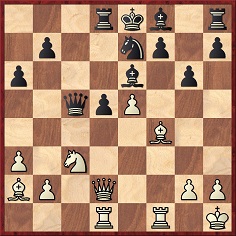
22 Ne4 Resigns.
What other games can be found, and do Dutch websites,
such as Delpher, have
relevant material?
We hope too that it will be possible to tie up loose ends, such as van Lennep’s victory over H.W. Trenchard in a match between the City of London and North London clubs on 9 February 1897. The report on pages 104-105 of the March 1897 BCM described it as ‘a beautiful game’, but the score was not given. However, on page 214 of the May 1898 BCM James Mason annotated a game between van Lennep and Trenchard which fits the bill but had no occasion specified:
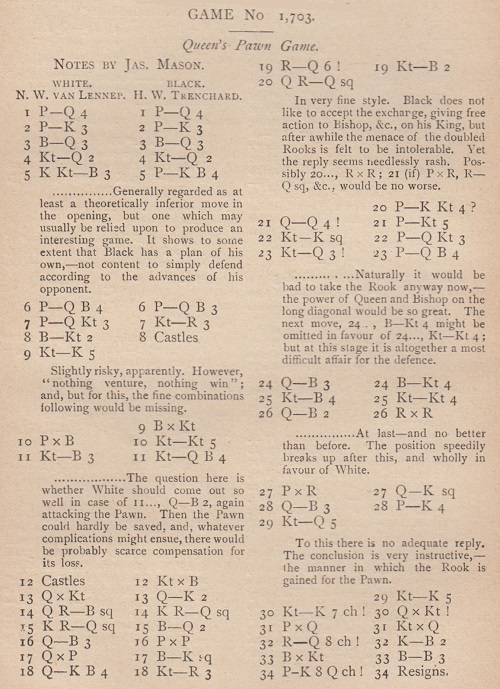
1 d4 d5 2 e3 e6 3 Bd3 Bd6 4 Nd2 Nd7 5 Ngf3 f5 6 c4 c6 7 b3 Nh6 8 Bb2 O-O 9 Ne5 Bxe5 10 dxe5 Ng4 11 Nf3 Nc5 12 O-O Nxd3 13 Qxd3 Qe7 14 Rac1 Rd8 15 Rfd1 Bd7 16 Qc3 dxc4 17 Qxc4 Be8 18 Qf4 Nh6 19 Rd6 Nf7

20 Rcd1 g5 21 Qd4 g4 22 Ne1 b6 23 Nd3 c5 24 Qc3 Bb5 25 Nf4 Ng5 26 Qc2 Rxd6 27 exd6 Qe8 28 Qc3 e5 29 Nd5 Ne4
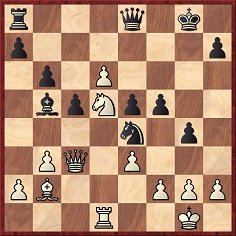
30 Ne7+ Qxe7 31 dxe7 Nxc3 32 Rd8+ Kf7 33 Bxc3 Bc6 34 e8(Q)+ Resigns.
10101. Freemasons
John Townsend (Wokingham, England) writes:
‘In my 2014 book Historical notes on some chess players, freemasons’ records were among the biographical sources for the chapter about Jacob Sarratt. The Library of Freemasonry in London was used, and since then many membership records of masons have been made searchable on-line at the genealogical website ancestry.co.uk (England, United Grand Lodge of England Freemason Membership Registers, 1751-1921). Below is some brief information on ten nineteenth-century chess personalities who were masons:
- Patrick Thomas Duffy: Grosvenor Lodge, Pimlico: initiated, 5 March 1872; aged 38; 16 Token House Yard; accountant;
George H.D. Gossip: Oak Lodge: initiated, 18 October 1871; aged 29; 8 Mayfield Terrace; gentleman;
Bernhard Horwitz: The Westbourne Lodge: initiated, 19 April 1860; 14 Southampton Street, Strand; importer of foreign goods;
John Jacob Löwenthal: Lodge of United Strength: initiated, 11 February 1868; 20 Camden Road; gentleman; resigned in 1870; Grosvenor Lodge, Pimlico: 1869-76;
Rev. George Alcock MacDonnell: Greenwood Lodge, Epsom, Surrey: initiated, 22 May 1886; aged 55; St. Pancras; clerk in orders;
George Webb Medley: Royal Athelstan Lodge: initiated, 27 February 1869; Chislehurst; stockbroker;
Samuel Newham: Royal Sussex Lodge: initiated, 3 March 1834; Nottingham; esquire;
George Perigal: Lodge of Fortitude and Old Cumberland: initiated, 14 December 1835; 57 Upper Tower Street; resigned in 1844;
Samuel Ries: Phoenix Lodge: initiated, 16 May 1838; 102 Strand; tobacconist; resigned in 1839;
- Antony Rosenbaum: Greenwood Lodge, Epsom, Surrey: initiated, 26 June 1886; aged 56; Guildford Street; artist.’
10102. Frank Melville Teed
No information has yet come to light on the excelsior composition in C.N. 9975, taken from page 12 of Ideal-Mate Chess Problems by Eugene Albert (Davis, 1966):
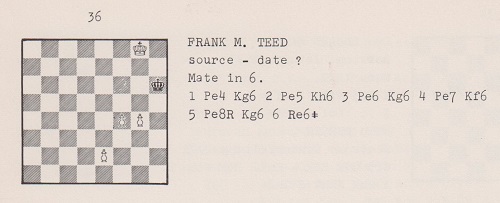
Early recognition of Teed came from Sam Loyd on page 1788 of the Scientific American Supplement, 23 February 1878:
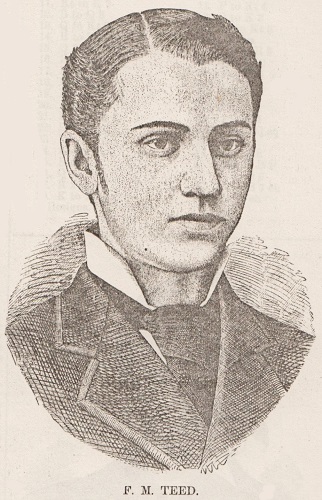
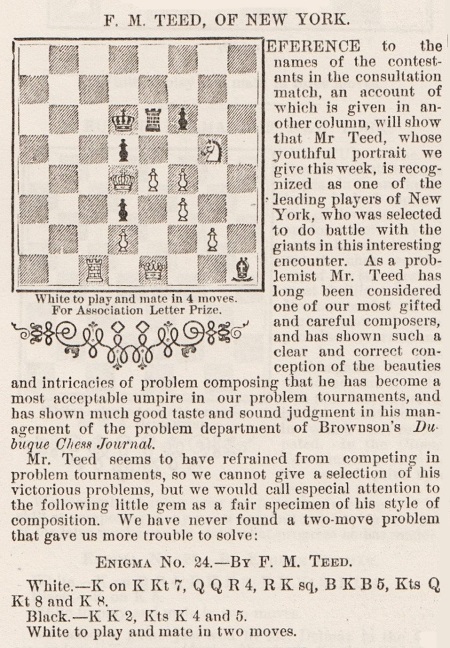
The ‘little gem’ regarding which Loyd remarked, ‘we have never found a two-move problem that gave us more trouble to solve’:
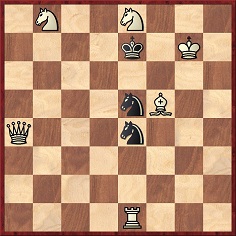
Another sketch of Teed was on the front page of the 28 January 1888 issue of the Columbia Chess Chronicle:

Next, a profile of Teed on page 9 of the Brooklyn Daily Eagle, 24 December 1896:

The game against Cohn is familiar, and the sketch is based on a photograph which later appeared on page 141 of the American Chess Magazine, August 1897:
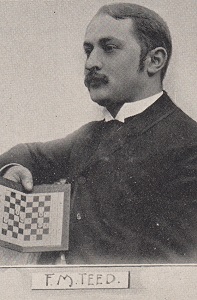
Page 164 of the same issue referred to the photograph:
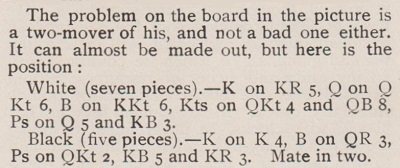
The picture in the American Chess Magazine was small, and a detail of the chessboard is of little help:
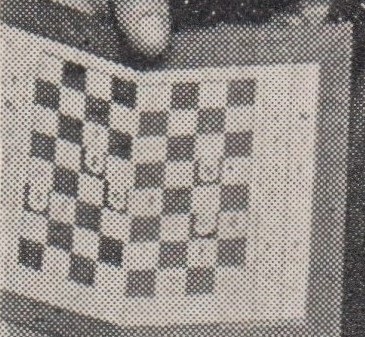
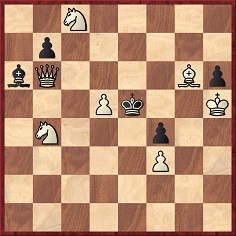
Finally, a feature marking Teed’s death from page 144 of the July-August 1929 American Chess Bulletin (mentioned in C.N. 6936):

10103. Constant paroxysms of laughter
From pages 40-41 of the Chess Monthly, October 1892:
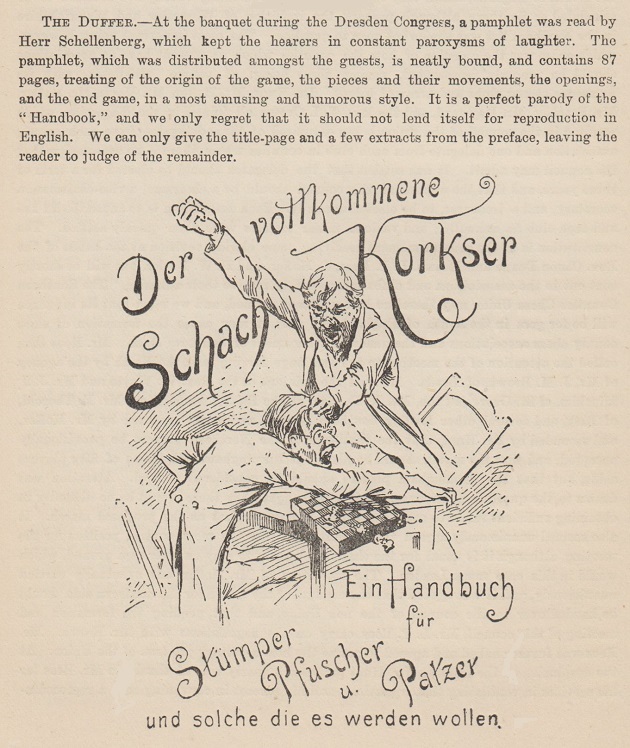
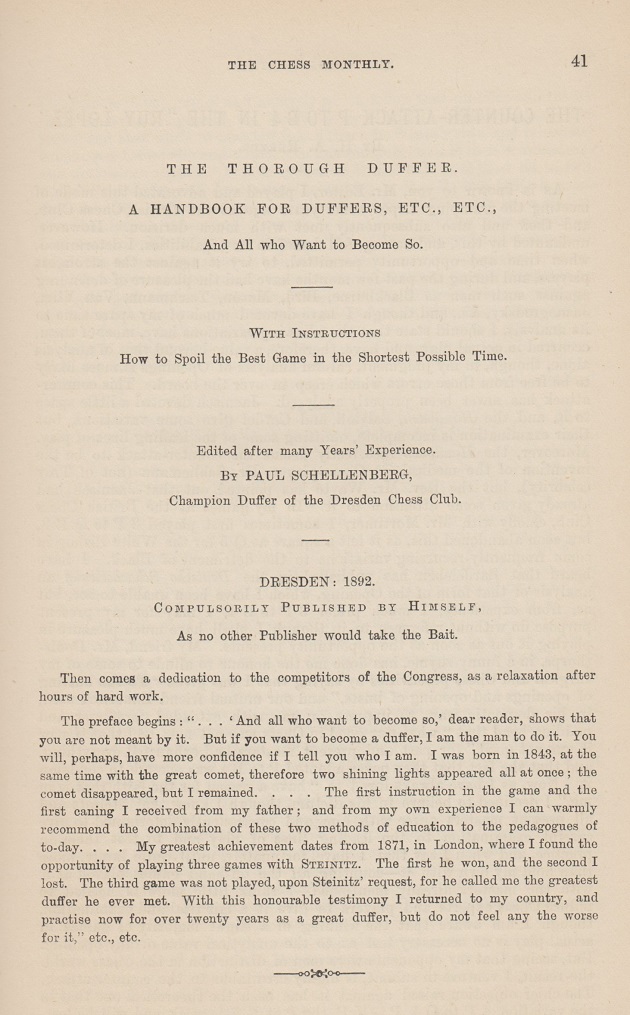
The Cleveland Public Library has kindly provided a complete scan of Der vollkommene Schach-Korkser, and a sample is shown below:
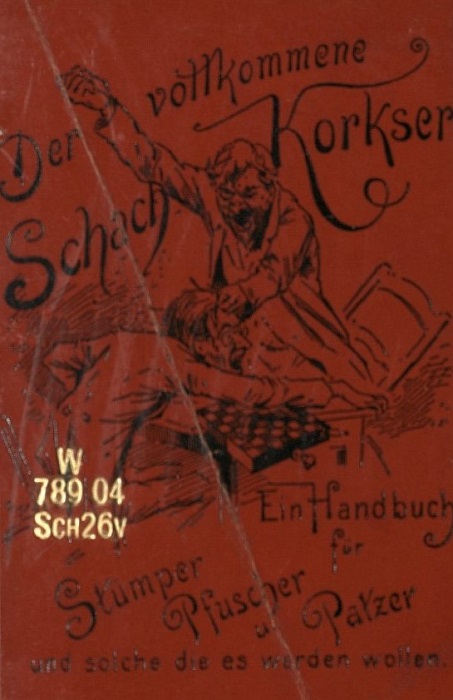
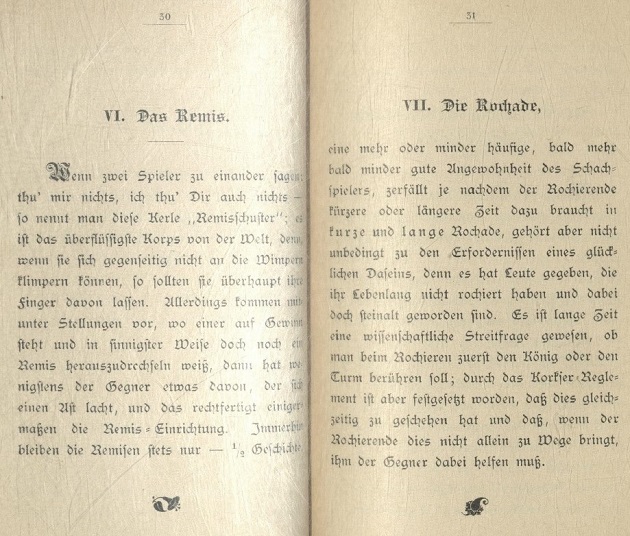
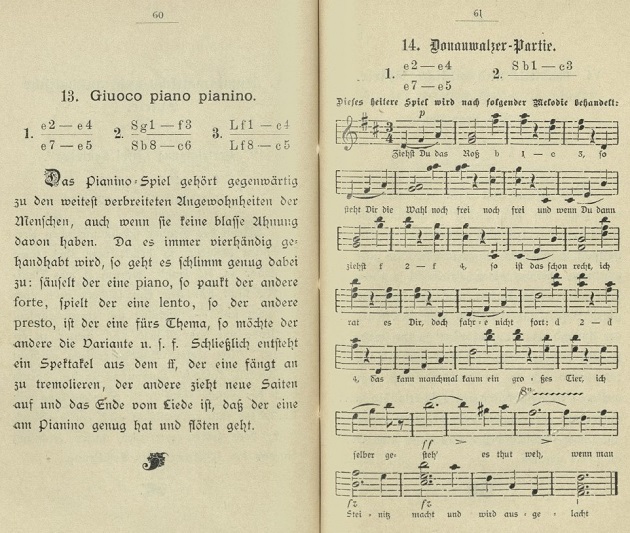
Much of the material was reproduced in Schellenberg’s book Lachschach (Leipzig, 1912).
From the second (posthumous) edition (Berlin and Leipzig, 1921):
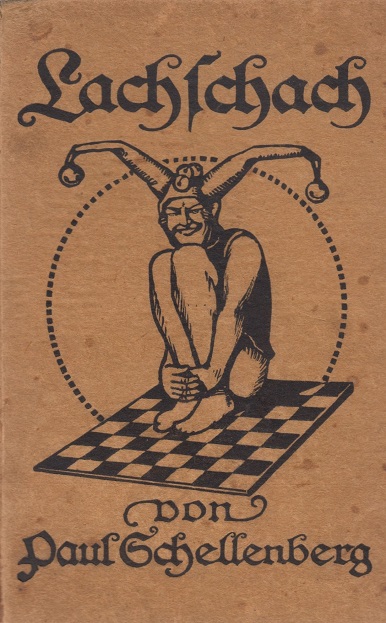
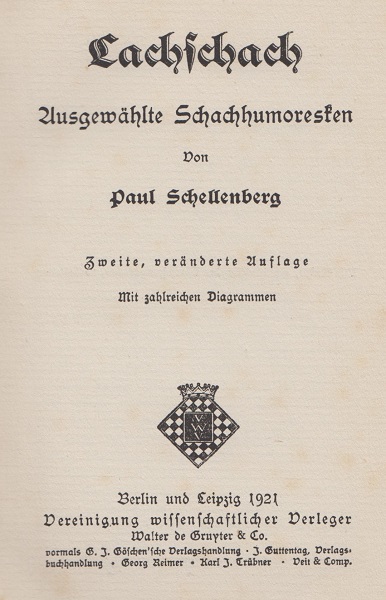
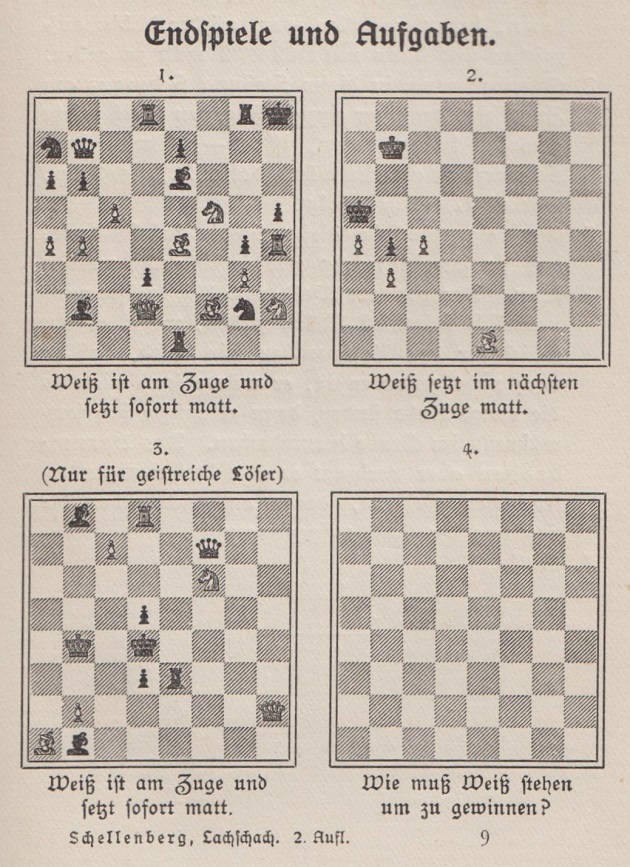
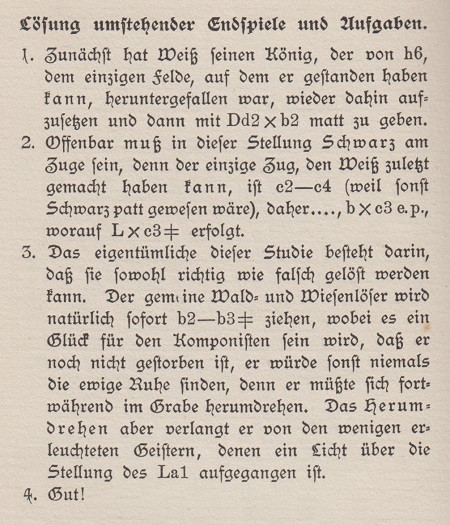
This portrait of Schellenberg was the Beilage to the 10 April 1904 issue of Deutsches Wochenschach:
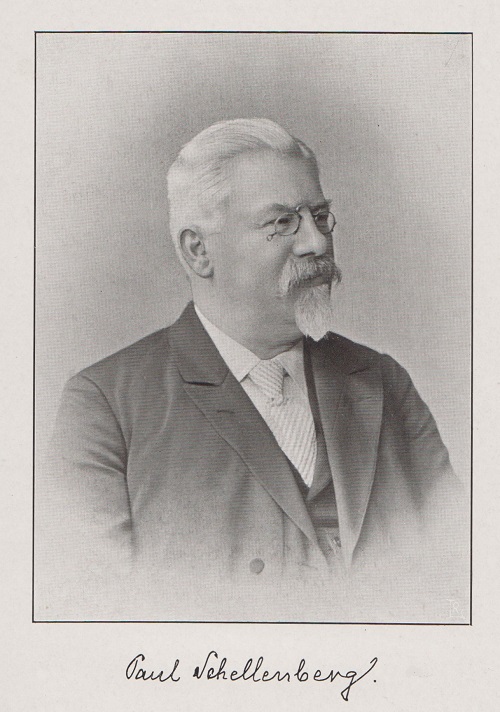
10104. Tilburg website
The Regionaal Archief Tilburg has many fine chess photographs.
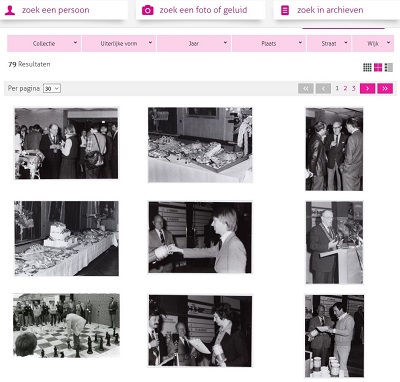
10105. Monticelli v Horowitz (C.N.s 10068, 10073 & 10076)
The white queen was placed on g3 rather than e4 when the conclusion was given, without the players’ names, on page 127 of Complete Book of Chess Stratagems by Fred Reinfeld (New York, 1958):
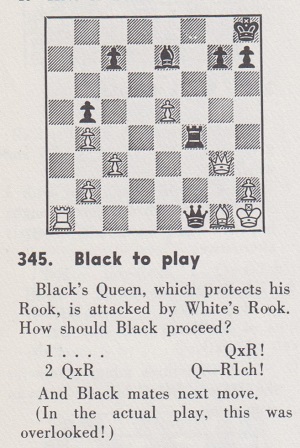
See also page 149 of the later edition, The Complete Book of Chess Tactics (New York, 1961).
10106. Wyke Bayliss v Norman van Lennep
A game which N.W. van Lennep drew against an eminent opponent who was discussed in C.N. 3361 (see pages 217-218 of Chess Facts and Fables):
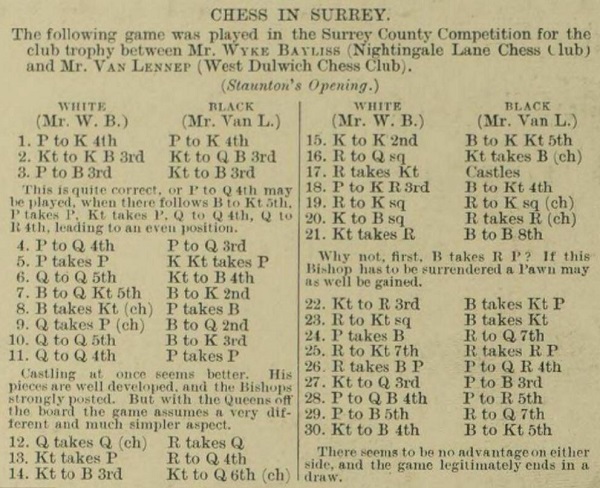
Source: Illustrated London News, 20 February 1897, page 260.
1 e4 e5 2 Nf3 Nc6 3 c3 Nf6 4 d4 d6 5 dxe5 Nxe4 6 Qd5 Nc5 7 Bb5 Be7 8 Bxc6+ bxc6 9 Qxc6+ Bd7 10 Qd5 Be6 11 Qd4 dxe5 12 Qxd8+ Rxd8 13 Nxe5 Rd5 14 Nf3
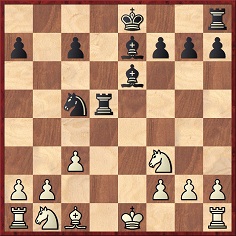
14...Nd3+ 15 Ke2 Bg4 16 Rd1 Nxc1+ 17 Rxc1 O-O 18 h3 Bg5 19 Re1 Re8+ 20 Kf1 Rxe1+ 21 Nxe1 Bc1 22 Na3 Bxb2 23 Rb1 Bxa3 24 hxg4 Rd2 25 Rb7 Rxa2 26 Rxc7 a5 27 Nd3 f6 28 c4 a4 29 c5 Rd2 30 Nf4 Bb4 Drawn.
10107. Charousek and the Handbuch (C.N. 8296)
From a biographical note on Rudolf Charousek on page 322 of the Chess Monthly, July-August 1896:
‘He learned the game of chess accidentally only five years ago at college in Kaschau, and this short apprenticeship was sufficient to advance him to the rank of master. Considering that there is not a single amateur of note at Kaschau – to our knowledge – it will be conceded to be rather remarkable that Charousek should have attained such a high degree of excellence solely from the study of the theory. With the latter he is thoroughly imbued. Not being rich enough at college to procure the German Handbuch, he set to work to copy one that was lent to him by a schoolfellow from beginning to end, a Herculean task which is to be hoped has not interfered with the curriculum of the college.’
10108. Keres webpage
Dan Scoones (Coquitlam, Canada) points out an Estonian webpage with many photographs of Paul Keres.
10109. Alekhine in Buenos Aires
Guy Gignac (Donnacona, Canada) informs us that he recently acquired this photograph:
Assistance with identifying the group will be welcomed.
10110. Guinness World Records

Annually since 2004 we have offered reports on the chess coverage – whether trivial, minuscule or non-existent – in Guinness World Records. The 2017 edition has just been received and is spectacularly different: chess receives a two-page spread.
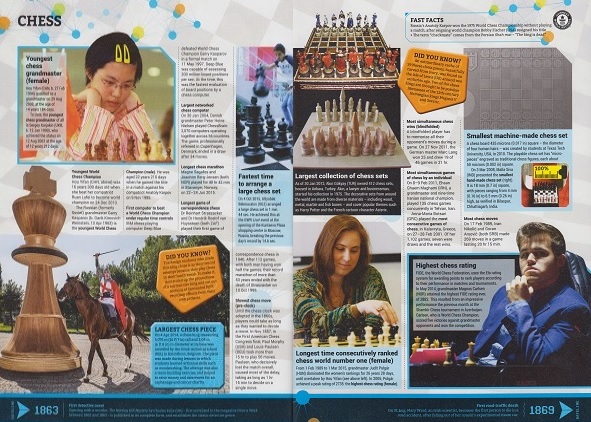
The topics on pages 144-145 are:
- Youngest chess grandmaster (female);
- Youngest chess grandmaster;
- Youngest World Chess Champion;
- Youngest World Chess Champion (male);
- First computer to beat a World Chess Champion under regular time controls;
- Largest networked chess computer;
- Longest chess marathon;
- Longest game of correspondence chess;
- Largest chess piece;
- Fastest time to arrange a large chess set;
- Slowest chess move (pre-clock);
- Largest collection of chess sets;
- Longest time consecutively ranked chess world number one (female);
- Highest chess rating (female);
- Most simultaneous chess wins (blindfolded);
- Most simultaneous games of chess by an individual;
- Most consecutive games of chess;
- Smallest machine-made chess set;
- Smallest hand-made chess set;
- Most chess moves;
- Highest chess rating.
There are also brief ‘fast facts’ and ‘did you know?’ items about: design students who made a large king; the Isle of Lewis chessmen; Karpov/Fischer in 1975; the origin of the term ‘checkmate’.
10111. A correspondental game
An addition will be made to Unusual Chess Words, from page 33 of the book discussed in C.N.s 10087 and 10088, A Popular Introduction to the Study and Practice of Chess (London, 1851) written by S.S. Boden but published anonymously:
‘To prevent unlimitedly tedious prolongation in a correspondental game between two clubs, there is generally a fixed time allowed for each move ...’
10112. Unnamed author
It is rare for a chess book written by a master not to have the author’s name on the cover (front, back or spine):
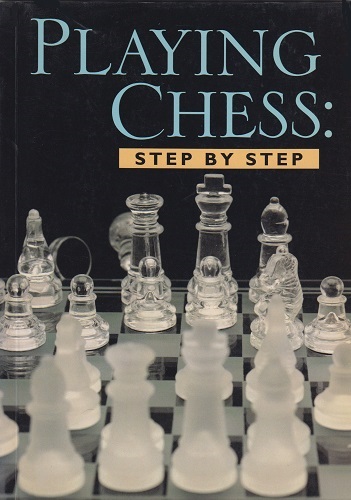
A list of information on the title page of the book (‘Playing Chess Step-by-Step’), which was published in 2004, includes ‘Written by Gary Lane’ in small letters, and there is a brief biographical note on the final page.
From page 46:

10113. Alekhine in Buenos Aires (C.N. 10109)
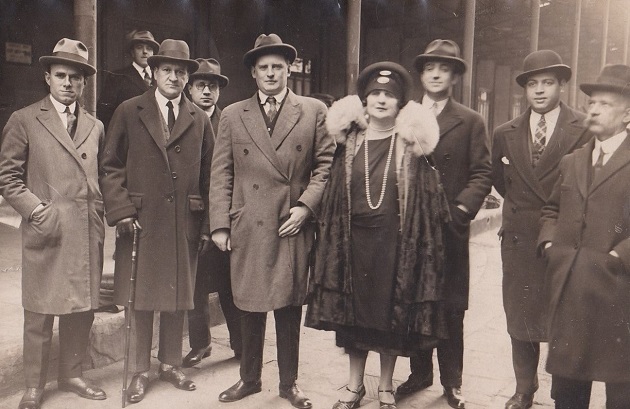
Michael Clapham (Ipswich, England) comments that the photograph appears to be a reverse image, given that the coats are buttoned on the left.
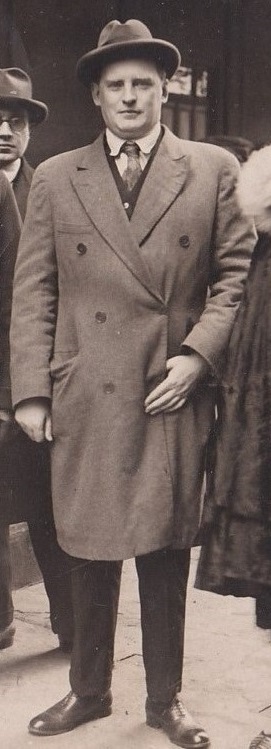

10114. Alekhine playing blindfold
The Gallica website of the Bibliothèque Nationale de France has a photograph of Alekhine playing blindfold at the Café de la Rotonde au Palais-Royal in Paris.
10115. Norman van Lennep (C.N.s 10100 & 10106)
Gerard Killoran (Ilkley, England) has submitted a number of columns with games by Norman Willem van Lennep, including one against J.T. Heppell on page 22 of the Illustrated London News, 2 January 1897:
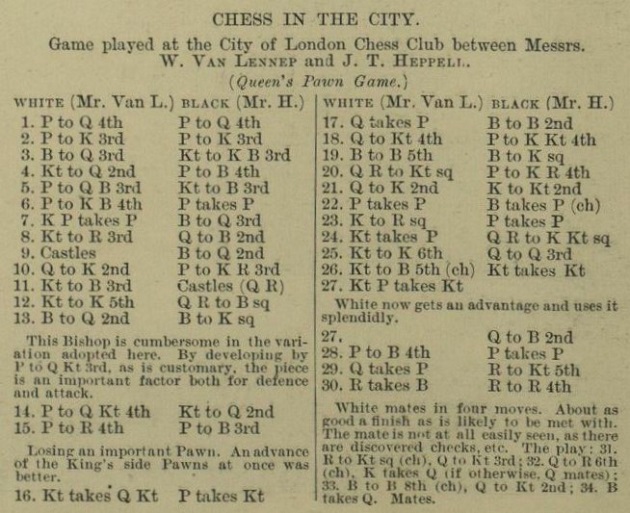
The score becomes impossible at move 27, but the full game makes sense if White’s 20th move is taken to be Rae1 and not Rab1 (‘QR to Ksq’ and not ‘QR to Ktsq’):
1 d4 d5 2 e3 e6 3 Bd3 Nf6 4 Nd2 c5 5 c3 Nc6 6 f4 cxd4 7 exd4 Bd6 8 Nh3 Qc7 9 O-O Bd7 10 Qe2 h6 11 Nf3 O-O-O 12 Ne5 Rdf8 13 Bd2 Be8 14 b4 Nd7 15 a4 f6 16 Nxc6 bxc6 17 Qxe6 Bf7 18 Qg4 g5 19 Bf5 Be8
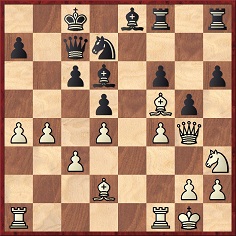
20 Rae1 (‘QR to Ktsq’) 20...h5 21 Qe2 Kb7 22 fxg5 Bxh2+ 23 Kh1 fxg5 24 Nxg5 Rfg8 25 Ne6 Qd6 26 Nc5+ Nxc5 27 bxc5 Qc7 28 c4 dxc4 29 Qxc4 Rg4 30 Rxe8 Rh4.
White mates in four moves: 31 Rb1+ Qb6

32 Qa6+ Kxa6 33 Bc8+ Qb7 34 Bxb7.
10116. Excuses for losing
On the topic of excuses for losing an addition comes from page 87 of the Chess Player’s Chronicle, 3 May 1899:
‘Another story of an excuse – same man. He had been cogitating some time and at length played. Notwithstanding his ruminations, however, he overlooked a slip mate on the board. “Ah!”, he exclaimed, “I was only looking for checks!”’
10117. Alekhine photograph
Hans Renette (Bierbeek, Belgium) forwards a photograph from page 3 of Die Deutsche Zeitung im Ostland, 26 September 1942:
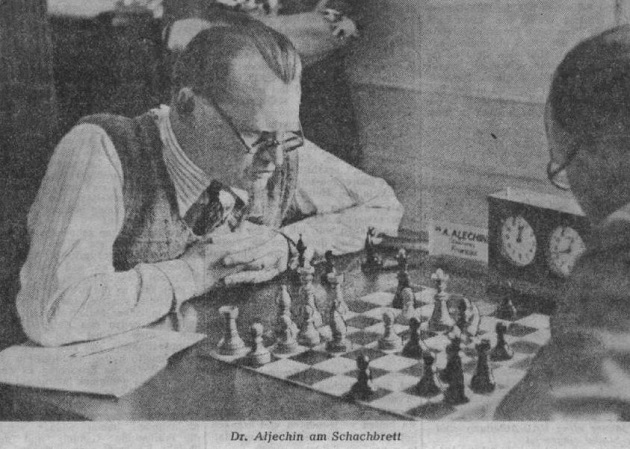
We included the picture in Kings, Commoners and Knaves, identifying the game as Alekhine v E. Steiner, Kemeri, 1937. The photograph had appeared, without any particulars, in Nad šachovnicemi celého světa by K. Opočenský and V. Houška (Prague, 1960):
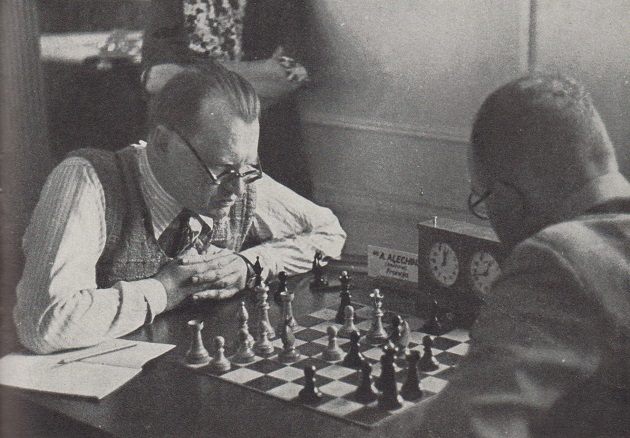
10118. Asleep at the board
Chess and Sleep includes some C.N. items on the story that Capablanca fell asleep during a game in the 1927 world championship match.
From pages 291-292 of the July 1987 BCM, in ‘My Meetings with Alekhine’, which was a translation of ‘an article by L. Lyubimov in Shakhmaty v SSSR, 1957, pages 248-249’:
‘“Is it true that Capablanca actually slept during play?”, asked Ye. Znosko-Borovsky, who was interviewing Alekhine.
“No, never”, was the reply, “and I cannot understand where this tale came from. There was one occasion when I was thinking and Capablanca was walking about the room that he took a seat some distance away, but as soon as I made my move he came back straight away and the game continued normally. Conditions of play left nothing to be desired. We were placed in a room which was separated from the public, who could watch the play through glass doors. Later on the public was even removed from there, as the noise from them began to disturb Capablanca.”’
10119. Oldest chess photograph (C.N.s 5977 & 5985)
Gene Milener (Renton, WA, USA) returns to the topic of early chess photographs and refers to one (Alois Löcherer: Chess Game; 1850/Calotype) which is slightly later than the shot discussed in C.N.s 5977 and 5985. We note that further information is provided on the website of the Harry Ransome Center (the University of Texas at Austin).
10120. Mieses and the triumph of youth
From the unpublished 1994 edition of Chess Personalia by Jeremy Gaige:
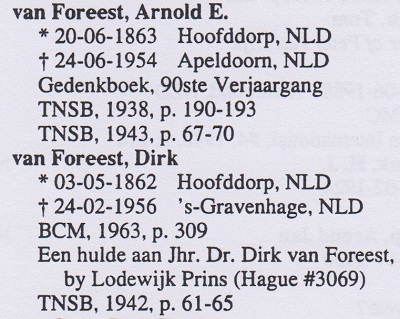
C.N. 2814 (see pages 69-70 of Chess Facts and Fables and Jacques Mieses) gave Mieses’ annotations to his famous victory (‘“Youth” has triumphed’) over Dirk van Foreest in the Hague on 26 March 1949. Although Mieses’ article (BCM, June 1949, pages 178-179, and shown in full in our feature article) specifically stated that his opponent was D. van Foreest, an on-line search for ‘youth has triumphed’ and ‘Arnold van Foreest’ will yield dissenting (unsourced, naturally) versions.
There is even this ‘pair’:
‘By the way, Arnold van Foreest plays a part in a well-known anecdote in which Jacques Mieses stars. In 1949, in The Hague, after Mieses (84 at the time) had won an exhibition game against Arnold (86), he caused much hilarity with the classic remark: “Youth has triumphed!”’
Source: ‘A Remarkable Chess Family’ by Hans Ree.
And:
‘Much later Dirk van Foreest gained a place in international chess lore because of a game in The Hague in 1949 between him and Jacques Mieses. Dirk van Foreest was 86 at the time. Mieses was much younger, a mere 84. Mieses won and exclaimed happily, “Youth has triumphed!”’
Source: ‘A Remarkable Family’ by Hans Ree.
10121. Paul Keres
A further rich selection of images concerning Keres is available at the website of the Eesti Muuseumide Veebivärav, through a search for either ‘Keres’ or the Estonian word for chess, ‘Male’.
10122. Jutta Hempel (C.N.s 1171, 1293, 7413 & 9613)
Michael Clapham (Ipswich, England) forwards an article on Jutta Hempel from the unnumbered pages 1-3 of volume three of Latvian Gambit (May-June 1970):
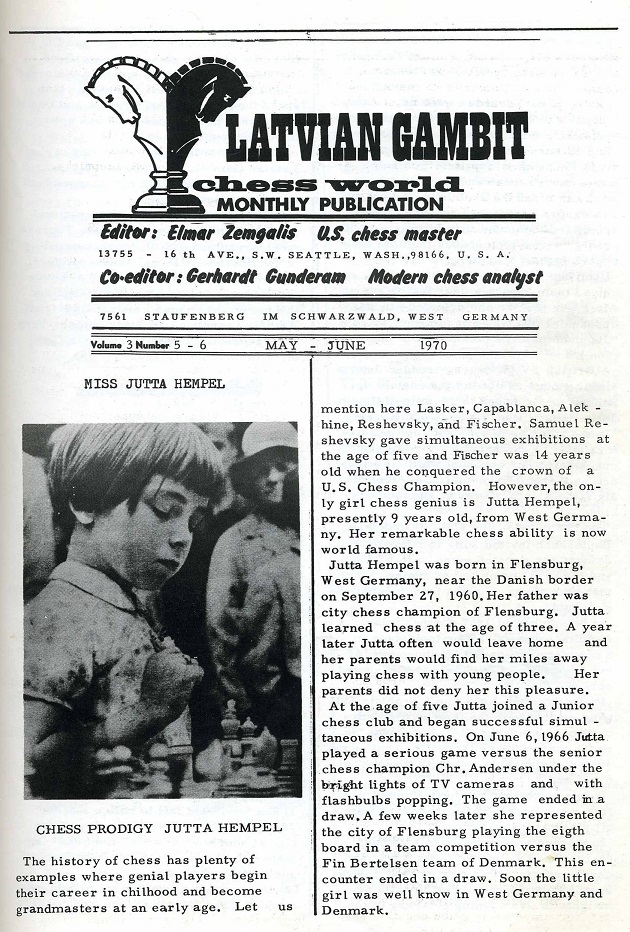
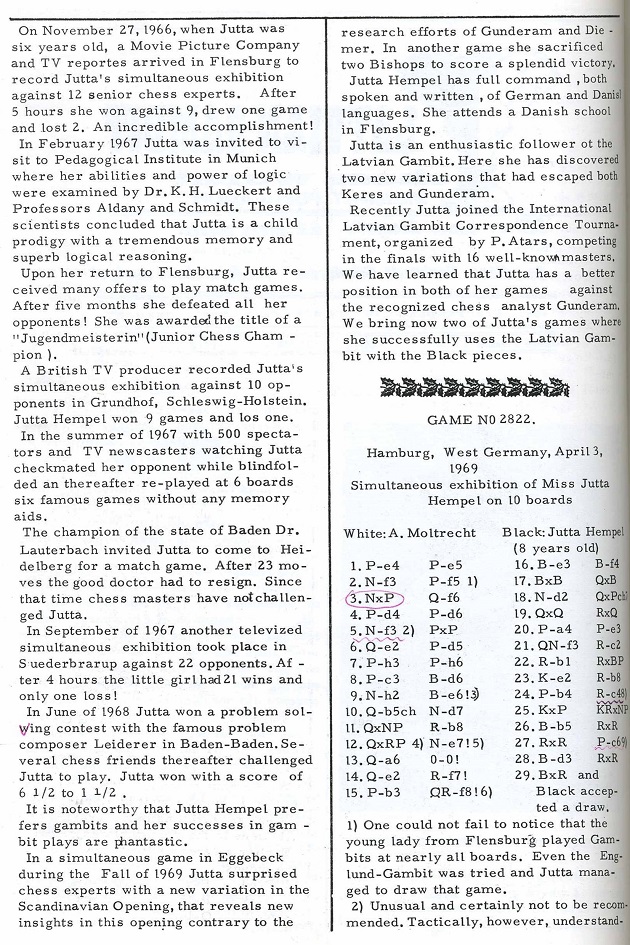
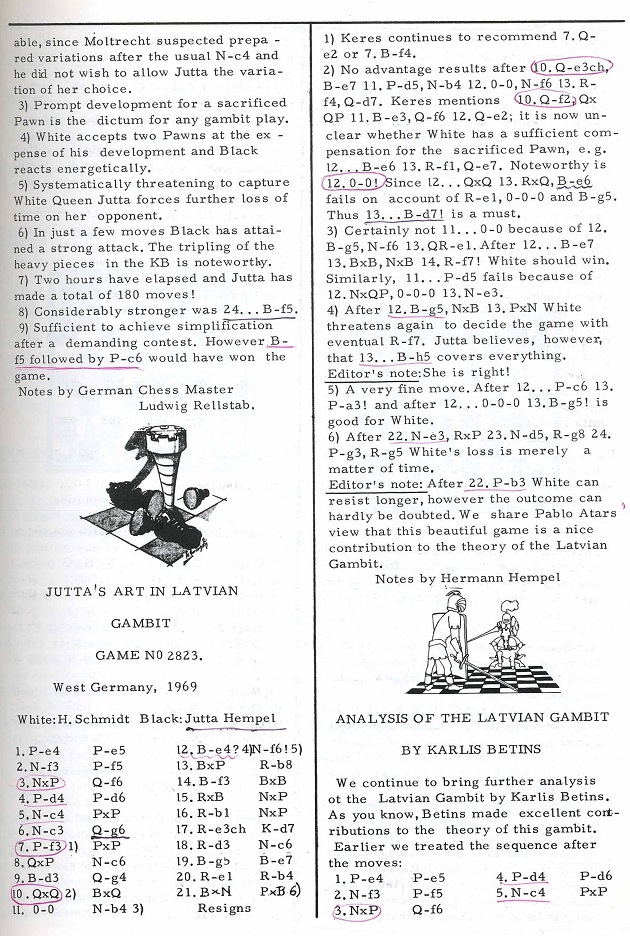
Our correspondent adds:
‘There are other brief references to Jutta Hempel and a further 18 of her games throughout volumes two to five of the periodical. It is stated that the co-editor, Gerhardt Gunderam, stayed with Jutta Hempel’s parents in 1969, and three pieces of analysis received from the Hempel family are given.
Among the games are one from a simultaneous exhibition in 1969, published on the unnumbered pages 3-4 of volume two (November-December 1969):
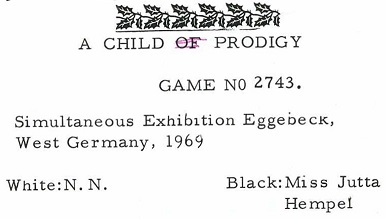
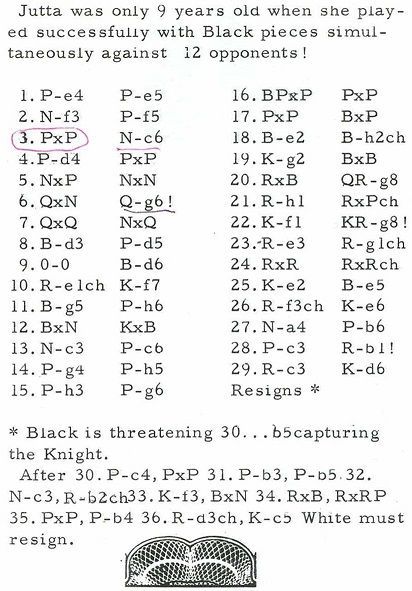
The other 17 games are all from the Kārlis Bētiņš Memorial Correspondence Tournaments from 1970 to 1972.’
Mr Clapham has also supplied the front cover of the August 1971 issue, which quoted a comment by Fischer:
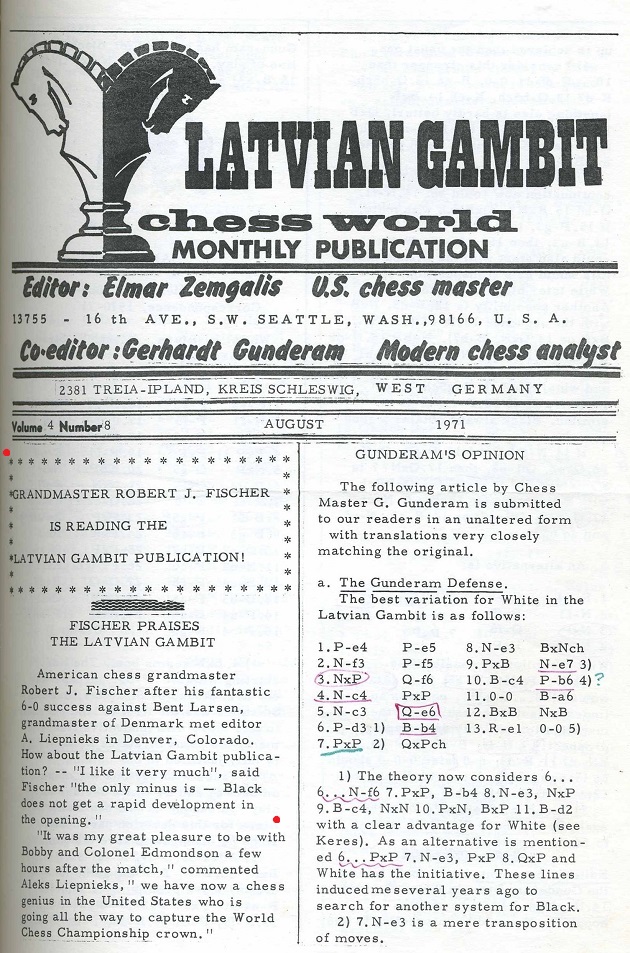
10123. ‘The Latvian Gambit’
Page 5 of Tony Kosten’s 1995 Batsford book on 1 e4 e5 2 Nf3 f5, [The] Latvian Gambit (the definite article is on the cover but not on the title page), stated that the opening ‘was renamed the Latvian Gambit at the 1937 FIDE Congress’.
The start of an article on the opening published earlier that year, on pages 74-75 of the Chess Review, April 1937:
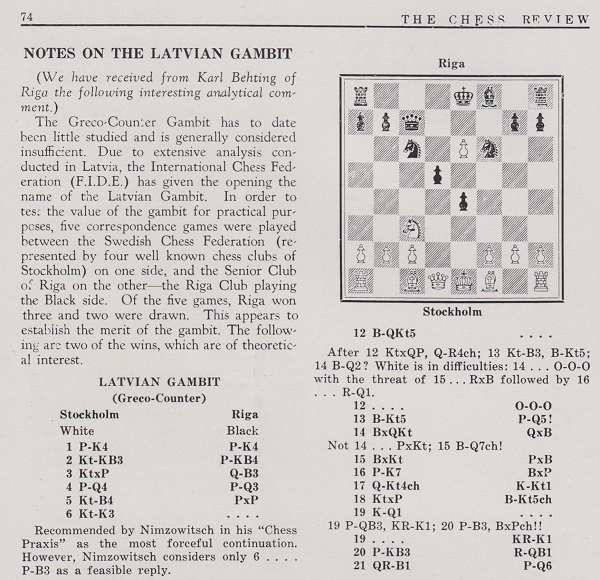
The name ‘Latvian Gambit’ had been officially adopted by FIDE several years earlier, in its publication discussed in C.N. 3902 and 10058, Débuts du jeu d’échecs (Prague, 1934). From page 35:

From page 81 of the sixth edition of Modern Chess Openings (Philadelphia, 1939):
‘... Greco’s Counter-Gambit has been given a new lease of life by the researches of Latvian analysts (particularly K. Behting), who maintain that the gambit is perfectly sound. Their analysis seems to be quite correct, but in practical play by Black usually loses.’
The earliest edition of Modern Chess Openings to include the specific term ‘Latvian Gambit’ was the seventh (London, 1946). From page 102:
‘The Greco Counter (now called Latvian) Gambit.’
Even so, in English-language sources the names remained more or less interchangeable. For instance, the May 1968 CHESS (pages 244-251) and the end-May 1968 issue (pages 281-284) had an ‘amazing article’ on 1 e4 e5 2 Nf3 f5 by B. Simm (‘Simms’ in the heading to the first part). The two parts were entitled, respectively, ‘The Latvian Gambit (alias Greco Counter-Gambit)’ and ‘The Latvian or Greco Counter-Gambit’.
To what extent modern theoreticians give due attention to old analysis is an uncomfortable question. To mention a couple of sources at random, there was a large amount of material, mainly by Stasch Mlotkowski, on the ‘Greco Counter-Gambit’ in the BCM in 1915-16, and a two-part article entitled ‘Zum Lettischen Gambit’ by Walter Henneberger was published in the Schweizerische Schachzeitung, January 1941, pages 6-9, and February 1941, pages 21-23.
10124. Atpūta (C.N. 10047)
Jan Kalendovský (Brno, Czech Republic) has forwarded another photograph from the Latvian magazine Atpūta (21 March 1941, page 31):
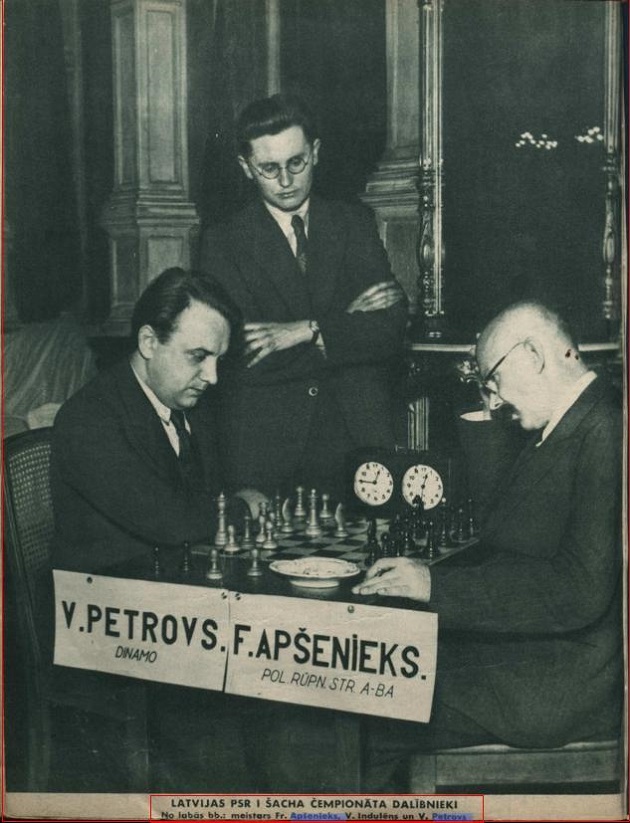
10125. Fischer v Karpov, 1975
Myron Samsin (Winnipeg, Canada) notes that on page 229 of the May-June 1975 CHESS Craig Pritchett gave an eye-witness report on the FIDE General Assembly held in Bergen on 18-20 March 1975, where Fischer’s match proposals were voted on for the final time. An extract, together with a comment by the Editor, B.H. Wood:

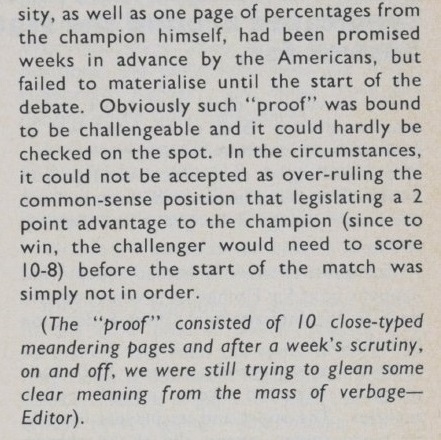
Our correspondent asks for more information about the calculations submitted by the Americans.
A huge amount of material on the topic (i.e. on the fairness or otherwise of Fischer’s proposed conditions) appeared in Chess Life & Review at the time. C.N. 2630 (see page 124 of A Chess Omnibus) mentioned the contribution of Charles Kalme, and we had particularly in mind his vast article ‘Bobby Fischer: An Era Denied’ on pages 717-729 of Chess Life & Review, November 1975. On page 715 of that issue, the Editor, Burt Hochberg, described the publication of Kalme’s article as ‘a momentous occasion in American chess’.

Chess Life & Review, November 1975, page 729
It will be appreciated if a reader can summarize, with brisk objectivity, the mathematical and statistical considerations underlying Fischer’s demands (i.e. his retention of the title in case of a 9-9 draw, and a score of 10-8 being required by his challenger to gain the world title).
As regards material submitted to the March 1975 extraordinary session of the General Assembly, details are sought. We have a large bound volume entitled ‘FIDE Papers 1972-75’, but the last document is dated 3 January 1975 (a letter to the Federations from the President, Max Euwe).
10126. Moral strength
Leafing through the FIDE volume referred to in the previous item, we noted the Statutes approved by the Federation on 25 June 1974:
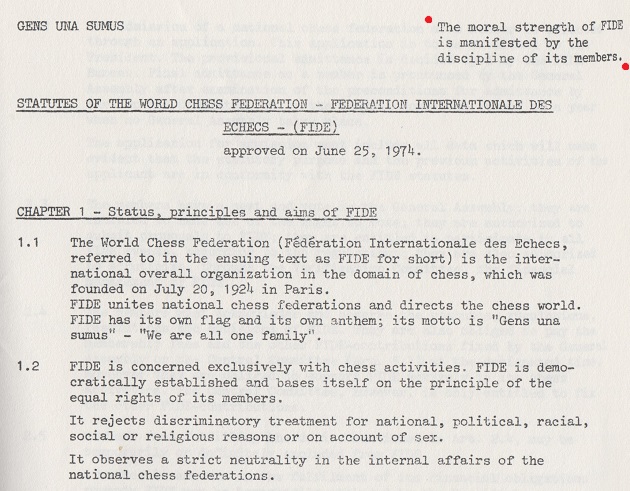
‘The moral strength of FIDE is manifested by the discipline of its members.’
It is unclear who conceived that promulgation, aspiration, exhortation or whichever other noun is most appropriate, but it remains at the top of FIDE’s Statutes even today.
10127. Mark
Dvoretsky (1947-2016)
On any list of the finest chess authors there is an assured place for Mark Dvoretsky, whose death has just been reported. Much of his best writing has been published by Russell Enterprises, Inc.
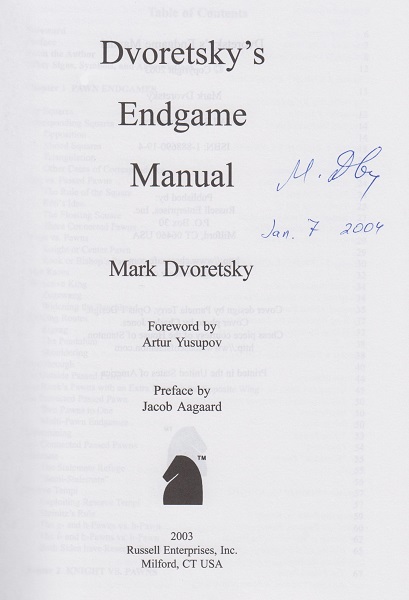
10128. Jutta Hempel (C.N.s 1171, 1293, 7413 & 10122)
From Leonard Barden (London):
‘The second page of the May-June 1970 issue of Latvian Gambit shown in C.N. 10122 states:
“Since that time [summer 1967] chess masters have not challenged Jutta.”
I should draw attention to Jutta Hempel’s disaster against Elaine Pritchard (who was a woman international master) which I personally witnessed.
Two games were played by radio by arrangement with the BBC World Service and a German radio station in autumn 1967. Elaine Pritchard had been a prodigy in the late 1930s, when she won the world girls’ and British women’s titles and performed well against Alekhine and Spielmann in simultaneous exhibitions. The objective of the radio programme was to find out how the two prodigies compared.
In the first game, Jutta Hempel had White and played to the standard of a weak club player and was crushed quickly by a king’s-side attack: 1 e4 e5 2 Nf3 Nc6 3 Bc4 Bc5 4 O-O d6 5 d3 Nf6 6 Bg5 h6 7 Bxf6 gxf6 8 h3 Be6 9 Bxe6 fxe6 10 Nc3 Qd7 11 Qd2 Qg7 12 Ne2 Rg8 13 Ng3 Qxg3 14 Ne1 Qxh3 15 c3 O-O-O 16 b4 Rxg2+ 17 Nxg2 Rg8 18 White resigns.
In the second game, she played 2...f6 and lost like a beginner. When the move came through from the German announcer, Elaine shook her head and shrugged. There was even more astonishment in the BBC studio at Black’s third move. The full game: 1 e4 e5 2 Nf3 f6 3 Nxe5 fxe5 4 Qh5+ Ke7 5 Qxe5+ Kf7 6 Bc4+ Resigns.
Afterwards, Jutta Hempel’s father could only say that she was nervous on the big occasion. But, of course, she had already successfully coped with even more demanding situations. Two leading German players of the time, Lothar Schmid and Rudolf Teschner, expressed scepticism to me about Jutta Hempel’s claimed exploits. The respected Deutsche Schachzeitung, edited by Teschner, never publicized her results, unlike the rival Schach-Echo, which was her major chess publicity outlet.
The two games against Elaine Pritchard can be found on-line easily enough, although they are wrongly attributed to her husband, David Pritchard.’
10129. Penalty move (C.N. 5381)
Concerning the game discussed in C.N. 5381, another version was quoted on page 30 of the October 1907 Chess Amateur (with, though, references to 3 Nb3 and to Scotland):
‘Short Game between Strong Players
We have in previous numbers quoted several very short games, some of which have actually occurred. Possibly, however, the shortest on record between good players and ending in mate is the following. It has been communicated by Mr C.S. Howell. 1 P-K4 P-Q4 2 PxP QxP 3 Kt-QKt3 (illegal move: penalty, replace Kt and move K): 3 K-K2 Q-K5 mate. The game was played in Scotland. Of course, the illegal move was due to carelessness on White’s part. At all events a mate in three moves in a game between strong players is remarkable.’
10130. Moreau
A number of C.N. items have discussed Colonel Moreau, and we wonder what to make of a comment about his performance at Monte Carlo, 1903 (all 26 games lost) on page 109 of The Batsford Book of Chess Records by Yakov Damsky (London, 2005):
‘After this, the colonel broke all records by the number of gifts he received! Sarcastic spectators brought him (or even posted him) hens’ and quails’ eggs, potatoes, tomatoes, apples, beads – in a word, anything shaped like a zero. Needless to say, each gift consisted of precisely 26 articles.’
10131. Mistaken identity
From page 33 of CHESS, October 2016:

This is another (gross) case of mistaken identity. As noted in our feature article on Alexander McDonnell, no picture of him is known. The above illustration in CHESS, given in C.N. 3974 and in Excuses for Losing at Chess, was the frontispiece to Chess Life-Pictures by George Alcock MacDonnell (London, 1883):
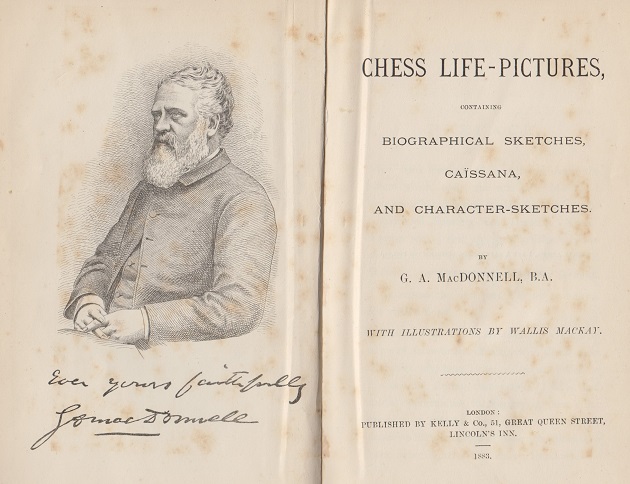
10132. The Orsini Gambit
Pages 242-243 of Il giuoco degli scacchi by Amerigo Seghieri and Emilio Orsini (Milan, 1907):
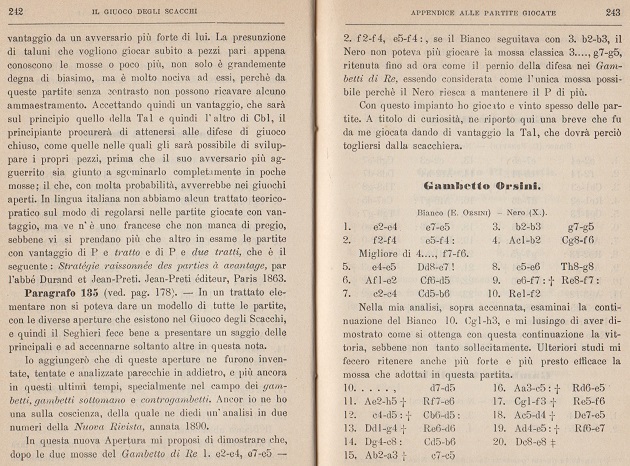
(Remove White’s queen’s rook.) 1 e4 e5 2 f4 exf4 3 b3 g5 4 Bb2 Nf6 5 e5 Qe7 6 Be2 Nd5 7 c4 Nb6 8 e6 Rg8 9 exf7+ Kxf7 10 Kf2 d5 11 Bh5+ Ke6 12 cxd5+ Nxd5 13 Qg4+ Kd6 14 Qxc8 Nb6 15 Ba3+ c5 16 Bxc5+ Ke5 17 Nf3+ Kf6 18 Bd4+ Qe5 19 Bxe5+ Ke7 20 Qe8 mate.
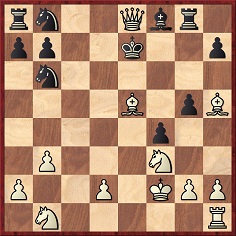
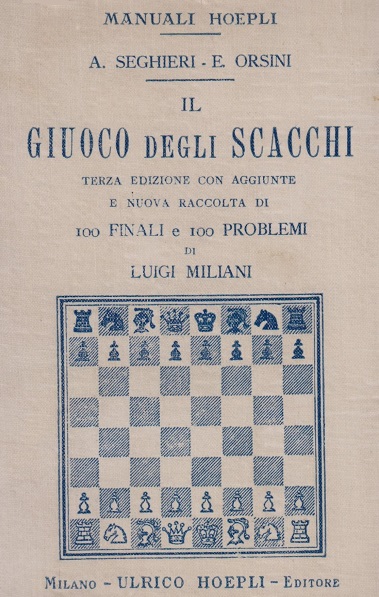
If a reader has an earlier edition of the book, we shall be grateful to know whether it gave more details about the singularly uninspiring odds game and the Orsini Gambit. Seghieri and Orsini died in 1894 and 1898 respectively.
10133. Morphy move by move
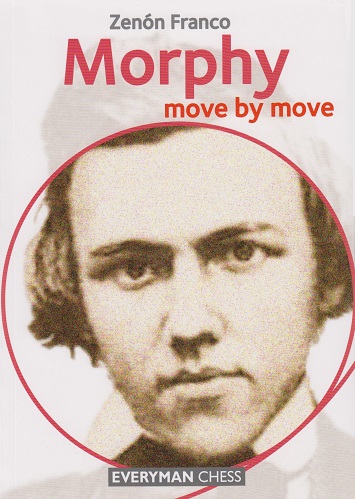
Any author of a book about Morphy has to decide how many of the dozens of monographs on him published since the late 1850s will be duly scrutinized and acknowledged in the bibliography.
Below is page 5 of Morphy move by move by Zenón Franco (London, 2016):
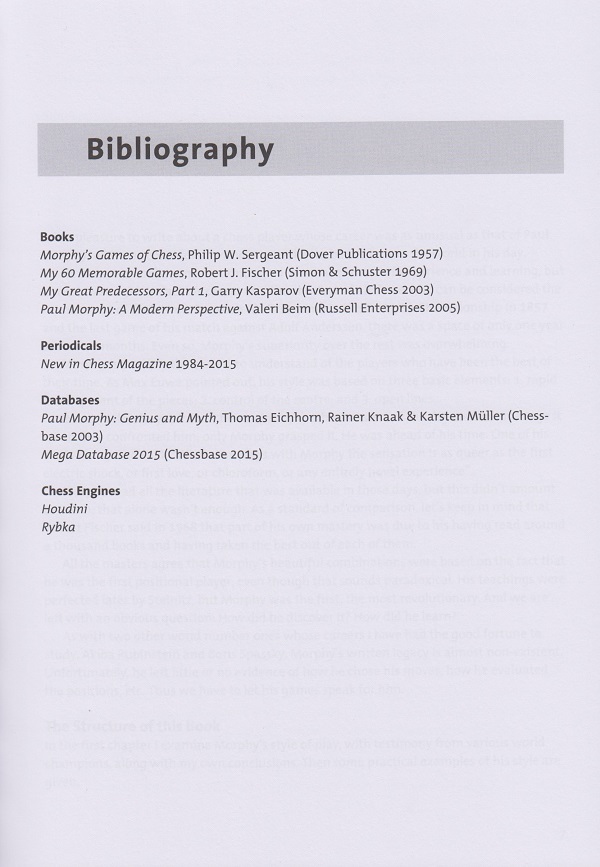
10134. Edward Lasker
Page 180 of the November 1921 American Chess Bulletin:
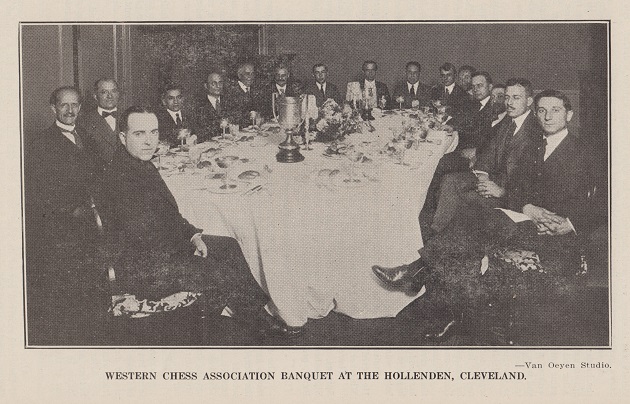
The key on the following page:
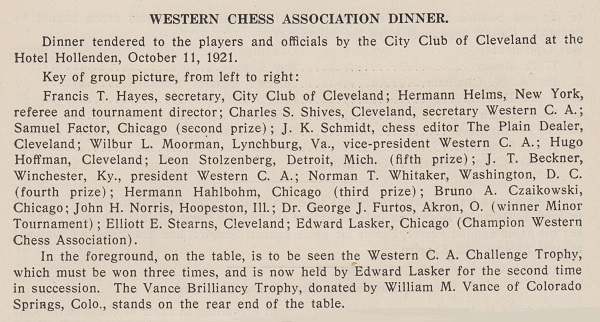
Larger version of the photograph
The tournament report on page 177 began:
‘For the fifth time in his career, Edward Lasker of Chicago, who in turn has been the champion of London, New York and Chicago, holds the proud title of champion of the Western Chess Association in consequence of his victory in the tournament held in connection with the annual meeting of that organization at the City Club of Cleveland in the Hotel Hollenden, Cleveland, O., from 5 to 13 October, inclusive.’
The event naturally had nothing to do with the US championship, a title held by F.J. Marshall from 1909 to 1936 and never won by Lasker. However, page 90 of The Rookie by Stephen Moss (London, 2016) refers to ‘Edward Lasker, a five-times US champion’.
After the Western Chess Association tournament, Lasker challenged Marshall for the US championship. His letter, dated 30 October 1921, was published on page 187 of the November 1921 American Chess Bulletin:
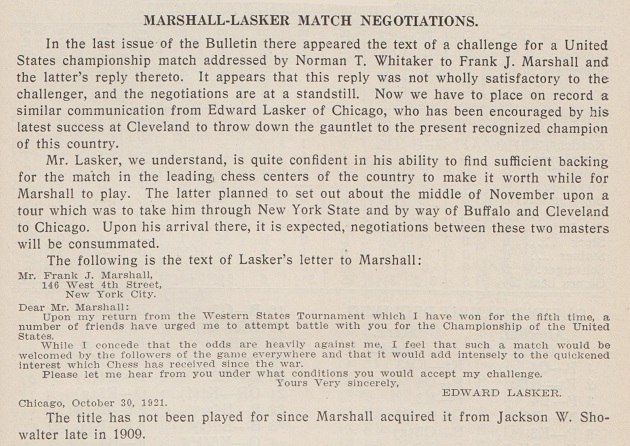
10135. Frederick Orrett
A further set of portraits by Frederick Orrett courtesy of Michael McDowell (Westcliff-on-sea, England):
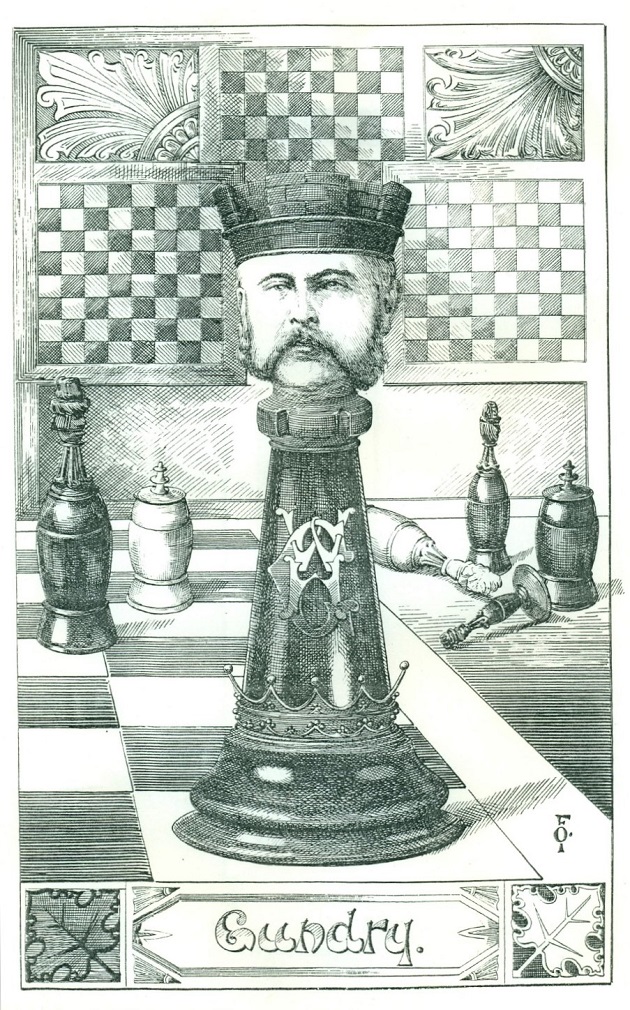
W. Henry Gundry
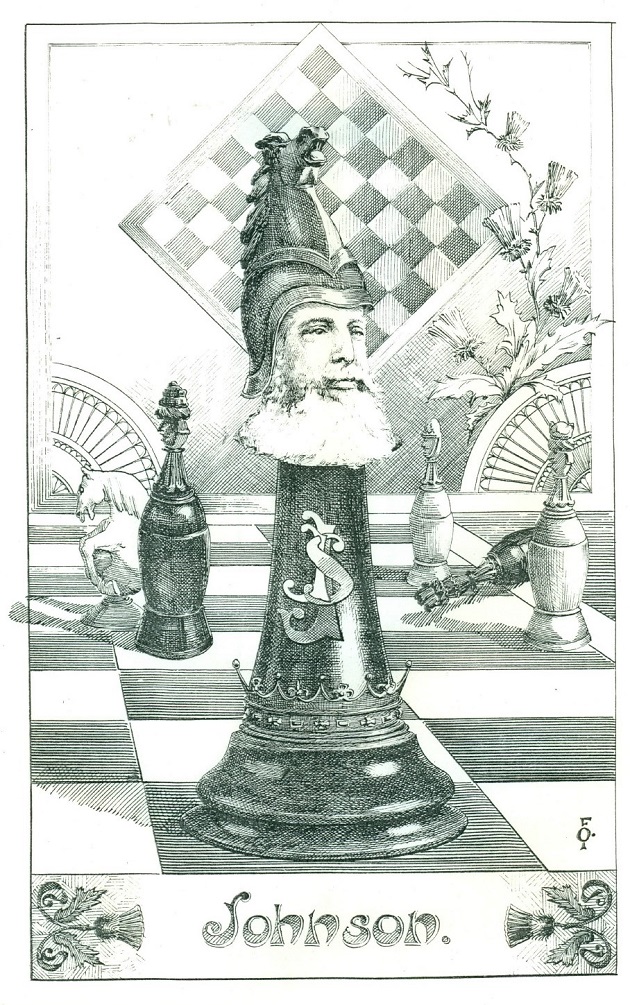
J.S. Johnson
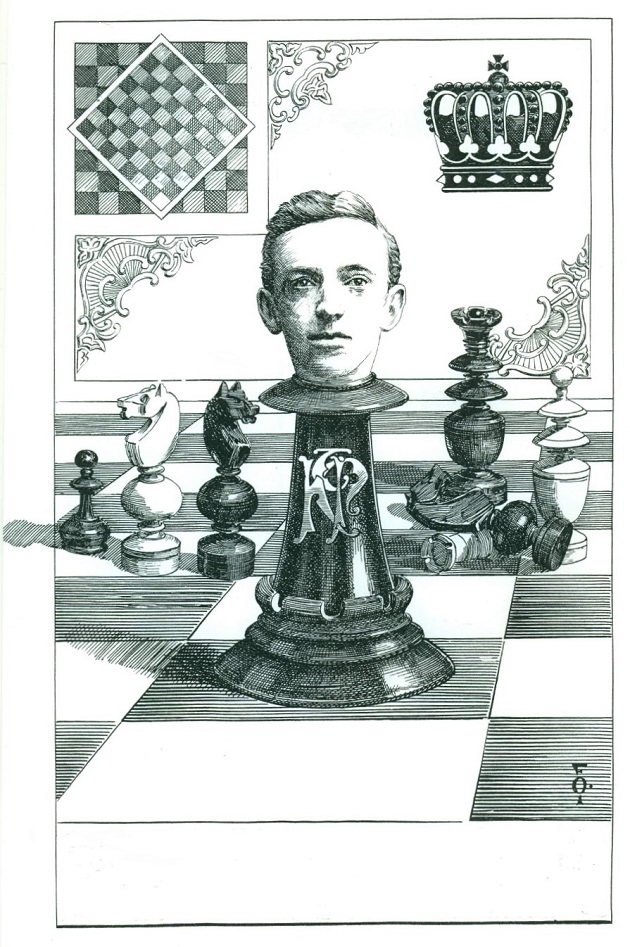
Thomas King-Parks
10136. Irving Chernev and radio broadcasts
From page 5 of Curious Chess Facts by Irving Chernev (New York, 1937):
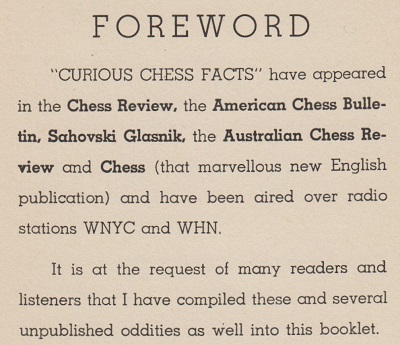
It is unclear from the wording whether Chernev himself broadcast the material on the radio.
A radio project had been announced on page 146 of the September 1934 Chess Review:
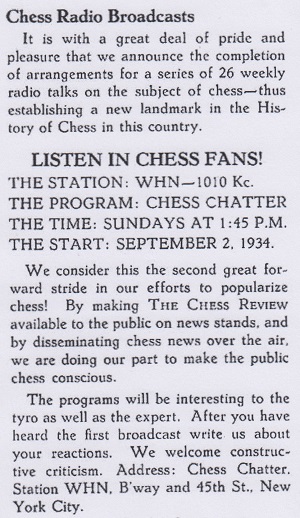
A follow-up item was published on page 102 of the May 1935 issue:

| First column | << previous | Archives [146] | next >> | Current column |
Copyright: Edward Winter. All rights reserved.
